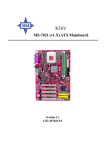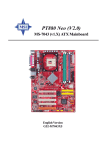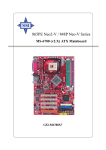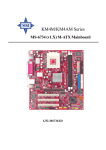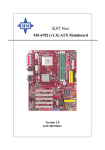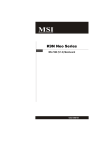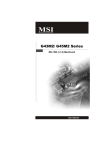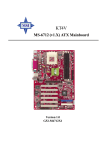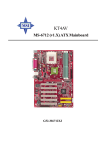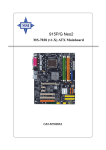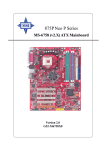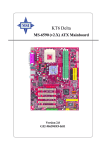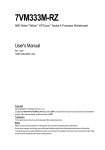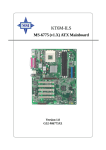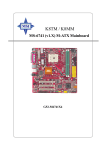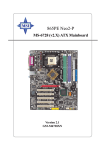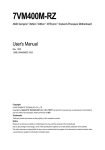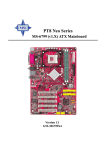Download MSI KT880 Delta Motherboard
Transcript
KT880 Delta MS-7047 (v1.X) ATX Mainboard G52-M7047X1 i Manual Rev: 1.0 Release Date: March 2004 FCC-B Radio Frequency Interference Statement This equipment has been tested and found to comply with the limits for a class B digital device, pursuant to part 15 of the FCC rules. These limits are designed to provide reasonable protection against harmful interference when the equipment is operated in a commercial environment. This equipment generates, uses and can radiate radio frequency energy and, if not installed and used in accordance with the instruction manual, may cause harmful interference to radio communications. Operation of this equipment in a residential area is likely to cause harmful interference, in which case the user will be required to correct the interference at his own expense. Notice 1 The changes or modifications not expressly approved by the party responsible for compliance could void the user’s authority to operate the equipment. Notice 2 Shielded interface cables and A.C. power cord, if any, must be used in order to comply with the emission limits. VOIR LA NOTICE D’INSTALLATION AVANT DE RACCORDER AU RESEAU. Micro-Star International MS-7047 This device complies with Part 15 of the FCC Rules. Operation is subject to the following two conditions: (1) this device may not cause harmful interference, and (2) this device must accept any interference received, including interference that may cause undesired operation ii Copyright Notice The material in this document is the intellectual property of MICRO-STAR INTERNATIONAL. We take every care in the preparation of this document, but no guarantee is given as to the correctness of its contents. Our products are under continual improvement and we reserve the right to make changes without notice. Trademarks All trademarks are the properties of their respective owners. AMD, Athlon™, Athlon™ XP, Thoroughbred™, and Duron™ are registered trademarks of AMD Corporation. Intel ® and Pentium® are registered trademarks of Intel Corporation. PS/2 and OS ® /2 are registered trademarks of International Business Machines Corporation. Microsoft is a registered trademark of Microsoft Corporation. Windows® 98/2000/NT/ XP are registered trademarks of Microsoft Corporation. NVIDIA, the NVIDIA logo, DualNet, and nForce are registered trademarks or trademarks of NVIDIA Corporation in the United States and/or other countries. Netware ® is a registered trademark of Novell, Inc. Award® is a registered trademark of Phoenix Technologies Ltd. AMI® is a registered trademark of American Megatrends Inc. Kensington and MicroSaver are registered trademarks of the Kensington Technology Group. PCMCIA and CardBus are registered trademarks of the Personal Computer Memory Card International Association. Revision History Revision V1.0 Revision History First release for PCB 1.X with VIA KT880 & VT8237 iii Date March 2004 Technical Support If a problem arises with your system and no solution can be obtained from the user’s manual, please contact your place of purchase or local distributor. Alternatively, please try the following help resources for further guidance. h Visit the MSI homepage & FAQ site for technical guide, BIOS updates, driver updates, and other information: http://www.msi.com.tw & http://www.msi. com.tw/program/service/faq/faq/esc_faq_list.php h Contact our technical staff at: [email protected] Safety Instructions 1. 2. 3. 4. 5. Always read the safety instructions carefully. Keep this User’s Manual for future reference. Keep this equipment away from humidity. Lay this equipment on a reliable flat surface before setting it up. The openings on the enclosure are for air convection hence protects the equipment from overheating. Do not cover the openings. 6. Make sure the voltage of the power source and adjust properly 110/220V before connecting the equipment to the power inlet. 7. Place the power cord such a way that people can not step on it. Do not place anything over the power cord. 8. Always Unplug the Power Cord before inserting any add-on card or module. 9. All cautions and warnings on the equipment should be noted. 10. Never pour any liquid into the opening that could damage or cause electrical shock. 11. If any of the following situations arises, get the equipment checked by a service personnel: h The power cord or plug is damaged. h Liquid has penetrated into the equipment. h The equipment has been exposed to moisture. h The equipment has not work well or you can not get it work according to User’s Manual. h The equipment has dropped and damaged. h The equipment has obvious sign of breakage. 12. Do not leave this equipment in an environment unconditioned, storage temperature above 60 0 C (140 0F), it may damage the equipment. CAUTION: Danger of explosion if battery is incorrectly replaced. Replace only with the same or equivalent type recommended by the manufacturer. iv CONTENTS FCC-B Radio Frequency Interference Statement ........................................................ ii Copyright Notice ........................................................................................................... iii Revision History ............................................................................................................ iii Safety Instructions ...................................................................................................... iv Technical Support ........................................................................................................ iv Chapter 1. Getting Started ................................................................................... 1-1 Mainboard Specifications ................................................................................... 1-2 Mainboard Layout ................................................................................................ 1-4 MSI Special Features .......................................................................................... 1-5 Color Management ........................................................................................ 1-5 Round Cable (Optional) ................................................................................. 1-6 Core CellTM Chip ............................................................................................. 1-7 Dynamic Overclocking Technology .............................................................. 1-8 Chapter 2. Hardware Setup ................................................................................. 2-1 Quick Component Guide ...................................................................................... 2-2 Central Processing Unit: CPU .............................................................................. 2-2 Memory Speed/CPU FSB Support Matrix ..................................................... 2-3 CPU Installation Procedures for Socket 462 ............................................... 2-4 Installing AMD Athlon CPU (Socket 462) Cooler Set .................................... 2-5 Memory ................................................................................................................ 2-6 Introduction to DDR SDRAM ......................................................................... 2-6 DDR Population Rules ................................................................................... 2-6 Installing DDR Modules .................................................................................. 2-7 Power Supply ...................................................................................................... 2-8 ATX 20-Pin Power Connector: JWR1 .......................................................... 2-8 ATX 12V Power Connector: JPW1 .............................................................. 2-8 Back Panel ........................................................................................................... 2-9 Mouse Connector (in green) ........................................................................ 2-9 Keyboard Connector (in purple) .................................................................. 2-9 USB 2.0 Connectors ..................................................................................... 2-9 Serial Port Connector: COM A .................................................................... 2-10 Audio Port Connectors ............................................................................... 2-10 RJ-45 LAN Jack: 10/100 LAN (VT6103L) / Giga-bit LAN (VT6122) (Optional) .................................................... 2-11 Parallel Port Connector: LPT1 ..................................................................... 2-12 Connectors ........................................................................................................ 2-13 Floppy Disk Drive Connector: FDD1 ........................................................... 2-13 v Fan Power Connectors: CFAN1 / SFAN1 / NBFAN1 ................................. 2-13 ATA133 Hard Disk Connectors: IDE1 & IDE2 ............................................. 2-14 Serial ATA/Serial ATA RAID Connectors controlled by VIA VT8237: SATA1, SATA2 (Optional) ................................................................... 2-15 Chassis Intrusion Switch Connector: J1 ................................................... 2-16 Front Panel Connectors: JFP1 & JFP2 ....................................................... 2-16 CD-In Connector: JCD1 ............................................................................... 2-17 D-Bracket™ 2 Connector: JLED1 ............................................................... 2-17 Front USB Connectors: JUSB1 & JUSB2 ................................................... 2-18 Front Panel Audio Connector: JAUD1 ........................................................ 2-18 Jumper ............................................................................................................... 2-19 Clear CMOS Jumper: JBAT1 ....................................................................... 2-19 Slots ............................................................................................................... 2-20 AGP (Accelerated Graphics Port) Slot ...................................................... 2-20 PCI (Peripheral Component Interconnect) Slots ........................................ 2-20 PCI Interrupt Request Routing .................................................................... 2-20 Chapter 3. BIOS Setup ........................................................................................... 3-1 Entering Setup ..................................................................................................... 3-2 Selecting the First Boot Device .................................................................... 3-2 Control Keys .................................................................................................. 3-3 Getting Help ................................................................................................... 3-3 Main Menu ..................................................................................................... 3-3 Default Settings ............................................................................................. 3-3 The Main Menu ..................................................................................................... 3-4 Standard CMOS Features ................................................................................... 3-6 Advanced BIOS Features ................................................................................... 3-8 Advanced Chipset Features ............................................................................. 3-10 Integrated Peripherals ....................................................................................... 3-12 Power Management Features .......................................................................... 3-15 PNP/PCI Configuration ....................................................................................... 3-18 H/W Monitor ....................................................................................................... 3-20 Cell Menu ............................................................................................................ 3-22 BIOS Setting Password .................................................................................... 3-25 Load Fail-Safe/Optimized Defaults ................................................................... 3-26 Chapter 4. Introduction to DigiCell .................................................................... 4-1 Main ................................................................................................................. 4-2 H/W Diagnostic .................................................................................................... 4-4 Communication ..................................................................................................... 4-5 vi Software Access Point ....................................................................................... 4-6 Terminology ................................................................................................... 4-6 Access Point Mode ....................................................................................... 4-7 WLAN Card Mode ......................................................................................... 4-8 Live Update .......................................................................................................... 4-9 MEGA STICK ...................................................................................................... 4-10 Basic Function ............................................................................................. 4-10 Non-Unicode programs supported ............................................................. 4-12 Core Center (for AMD K8 Processor) .............................................................. 4-14 Audio Speaker Setting ...................................................................................... 4-16 Power on Agent ................................................................................................. 4-18 Power On .................................................................................................... 4-18 Power Off / Restart .................................................................................... 4-19 Start With ..................................................................................................... 4-19 Auto Login ................................................................................................... 4-19 Chapter 5. VIA VT8237 Serial ATA RAID Introduction .................................... 5-1 Introduction .......................................................................................................... 5-2 BIOS Configuration ............................................................................................... 5-3 Create Disk Array .......................................................................................... 5-4 Delete Disk Array ........................................................................................... 5-6 Create and Delete Spare Hard Drive ............................................................. 5-7 View Serial Number of Hard Drive ................................................................ 5-7 Duplicate Critical RAID 1 Array ...................................................................... 5-8 Rebuild Broken RAID 1 Array ........................................................................ 5-8 Installing RAID Software & Drivers .................................................................. 5-10 Installation of VIA SATA RAID Utility ............................................................ 5-11 Using VIA RAID Tool .......................................................................................... 5-13 Appendix A. Using 2-, 4- & 6- Channel Audio Function ............................... A-1 Installing the Audio Driver .................................................................................. A-2 Software Configuration ..................................................................................... A-4 Using 2-, 4- & 6- Channel Audio Function ......................................................... A-7 vii Getting Started Chapter 1. Getting Started Getting Started Thank you for choosing the KT880 Delta (MS-7047 v1.X) ATX mainboard. The KT880 Delta is based on VIA® KT880 & VT8237 chipsets for optimal system efficiency. Designed to fit the advanced AMD ® AthlonTM XP/Duron processors in 462 pin package, the KT880 Delta delivers a high performance and professional desktop platform solution. 1-1 MS-7047 ATX Mainboard Mainboard Specifications CPU h Supports Socket A (Socket-462) for AMD® Athlon™ XP /Duron™ processors. h FSB @ 400 MHz. h Supports up to 3200+ or higher speed. (For the latest information about CPU, please visit http://www.msi.com.tw/program/ products/mainboard/mbd/pro_mbd_cpu_support.php) Chipset h VIA® KT880 chipset - Supports FSB 400/333/266 MHz. - Supports AGP 8X/4X interface. - Supports Dual-channel DDR 400/333/266 memory interface. h VIA® VT8237 chipset - High Bandwidth V-link Client controller - Integrated Faster Ethernet LPC - Integrated Hardware Sound Blaster/Direct Sound AC97 audio - Ultra DMA 66/100/133 master mode PCI EIDE controller - ACPI - Supports Serial ATA - Supports USB2.0 Main Memory h Supports six memory banks using three 184-pin DDR DIMMs h Supports a Dual-channel memory h Supports a maximum memory size up to 3GB h Supports 2.5v DDR SDRAM DIMM (For the updated supporting memory modules, please visit http://www.msi.com.tw/ program/products/mainboard/mbd/pro_mbd_trp_list.php to refer the memory module part in the test report.) Slots h One AGP (Accelerated Graphics Port) slot supports AGP 3.0 8x h Five 32-bit Master PCI bus slots (support 3.3v/5v PCI bus interface). h Supports 3.3V/5V PCI bus Interface On-Board IDE h An IDE controller integrated in the VIA® VT8237 chipset. - Supports IDE HDD/CD-ROM with PIO, Bus Master and Ultra DMA 66/100/133 operation modes. - Can connect up to four Ultra ATA drives. h Serial ATA/150 controller integrated in VIA® VT8237 chipset. - Up to 150MB/sec transfer rate. - Can connect up to two Serial ATA drives with RAID0 & RAID1. 1-2 Getting Started On-Board Peripherals h On-Board Peripherals include: - 1 floppy port supports 2 FDDs with 360K, 720K, 1.2M, 1.44M and 2.88Mbytes - 1 serial ports (COM A) - 1 parallel port supports SPP/EPP/ECP mode - 8 USB 2.0 ports (Rear x 4 / Front x 4) - 1 RJ45 LAN jack - 1 D-Bracket2 pinheader - 1 Line-In / Line-Out /Mic - 1 RCA SPDIF-Out Audio h AC97 link controller integrated in VIA® VT8237 h 6-channel software audio codec VIA ® VT1617A - Compliance with AC97 v2.2 Spec - Meets PC2001 audio performance requirement LAN (Optional) h VIA® VT8237 integrated MAC + VIA® VT6122 / VT6103L (Optional) - Auto-negotiation operation of 10/100 LAN phy (VT6103L) or Giga-bit LAN phy (VT6122) BIOS h The mainboard BIOS provides “Plug & Play” BIOS which detects the peripheral devices and expansion cards of the board automatically. h The mainboard provides a Desktop Management Interface (DMI) function which records your mainboard specifications. Dimension h ATX Form Factor: 29.5cm x 21.5cm. Mounting h 6 standard mounting holes. 1-3 MS-7047 ATX Mainboard Mainboard Layout Top : mouse Bottom: keyboard CFAN1 ATX Power Supply JWR1 DIMM 3 DIMM 2 DIMM 1 SO CKET 462 Top : Parallel Port Bottom: COM A T: SPDIFOut B:USB port VIA KT880 T: LAN jack B: USB ports FDD1 Winbond W83697HF T: Line-In M: Line-Out B: Mic NBFAN1 JPW1 J1 MSI CoreCell JLED1 BIOS AGP Slot BATT + PCI Slot 1 VT6122/VT6103L (Optional) PCI Slot 2 SATA1 SATA2 VT8237 JAUD1 PCI Slot 3 SFAN1 IDE 1 VIA VT1617A PCI Slot 4 IDE 2 JFP2 JCD1 PCI Slot 5 JBAT1 JUSB1 JUSB2 JFP1 KT880 Delta (MS-7047) v1.X ATX Mainboard 1-4 Getting Started MSI Special Features Color Management MSI has a unified color management rule for some connectors on the mainboards, which helps you to install the memory modules, expansion cards and other peripherals devices more easily and conveniently. h h h h h Standard IDE ATA66/100/133 connector: yellow Serial ATA150 connector: orange AGP 8X slot: red USB 2.0 connector: yellow Front panel connector JFP1: HDD LED in red, Reset Switch in blue, Power Switch in black, Power LED in light green. h Front panel connector JFP2: Power LED in light green, speaker in yellow. h PCI/Communication Slot: orange SOCKET 462 AGP 8X Slot Serial ATA Connectors Standard IDE ATA66/ 100/133 Connectors Front Panel Connector JFP2 PCI/Communication Slot USB 2.0 Connectors Front Panel Connector JFP1 1-5 MS-7047 ATX Mainboard Round Cable (Optional) Round cable is an enhanced cable for PCI IDE and Ultra DMA controller. It has the following benefits: h Data transfer rate started by 133MB/s h Backward compatibility (ATA33/66/100/133) h Higher performance than traditional Flat cable (data rate) h Improved data robustness h Better airflow due to thinner ATA/133 cable Connect to the system connectors on the mainboard. Connect to the master drive. Connect one end to the floppy disk drive connector (FDD1) and the other end to the standard floopy disk. Connect to the slave drive. 1-6 Getting Started Core CellTM Chip By diagnosing the current system utilization, the CoreCell™ Chip automatically tunes your motherboard to the optimal state, leading to less noise, longer duration, more power-saving and higher performance. Features of CoreCell™ Speedster -- Advanced O.C. design. -- Superior O.C. capability. -- Greater O.C. method. PowerPro -- Saves up to 65% power. -- Assures motherboard stability. -- Empowers O.C Capability. BuzzFree -- Diagnoses current system utilization & temperature. -- Controls both CPU and System fans. -- Cuts up to 50% of system noise. LifePro -- Prolongs motherboard, CPU and fan life. -- Maintains motherboard & CPU in constant temperature. -- Prevents components from operating beyond specifications. 1-7 MS-7047 ATX Mainboard Dynamic Overclocking Technology Dynamic Overclocking Technology is the automatic overclocking function. It is designed to detect the load balance of CPU while running programs, and to adjust the best CPU frequency automatically. When the motherboard detects CPU is running programs, it will speed up CPU automatically to make the program run smoothly and faster. When the CPU is temporarily suspending or staying in the low load balance, it will restore the default settings instead. Usually the Dynamic Overclocking Technology will be powered only when users' PC need to run huge amount of data like 3D games or the video process, and the CPU frequency need to be boosted up to enhance the overall performance. D.O.T Dynamic Overclocking Technology MSI Reminds You... Even though the Dynamic Overclocking Technology is more stable than manual overclocking, basically, it is still risky. We suggest user to make sure that your CPU can afford to overclocking regularly first. If you find the PC appears to be unstable or reboot incidentally, it's better to disable the Dynamic Overclocking or to lower the level of overclocking options. By the way, if you need to conduct overclocking manually, you also need to disable the Dynamic OverClocking first. 1-8 Hardware Setup Chapter 2. Hardware Setup Hardware Setup This chapter tells you how to install the CPU, memory modules, and expansion cards, as well as how to setup the jumpers on the mainboard. Also, it provides the instructions on connecting the peripheral devices, such as the mouse, keyboard, etc. While doing the installation, be careful in holding the components and follow the installation procedures. 2-1 MS-7047 ATX Mainboard Quick Components Guide JPW1, p.2-8 CPU, p.2-3 CFAN1, p.2-13 DDR DIMMs, p.2-6 J1, p.2-16 SO CKET 462 JWR1, p.2-8 Back Panel I/O, p.2-9 NBFAN1, 2-13 FDD1, p.2-13 JLED1, p.2-17 AGP Slot, p.2-20 PCI Slots, p.2-20 SATA1,SATA2, p.2-15 JAUD1, p.2-18 SFAN1, p.2-13 JFP2, p.2-16 JCD1, p.2-17 JFP1, p.2-16 JBAT1, p.2-19 IDE1, IDE2, p.2-14 JUSB1, JUSB2, p.2-18 2-2 Hardware Setup Central Processing Unit: CPU The mainboard supports AMD® Athlon™ XP and Duron™ processors in the 462 pin package. The mainboard uses a CPU socket called Socket-462 for easy CPU installation. When you are installing the CPU, make sure the CPU has a heat sink and a cooling fan attached on the top to prevent overheating. If you do not find the heat sink and cooling fan, contact your dealer to purchase and install them before turning on the computer. For the latest information about CPU, please visit http://www.msi.com.tw/ program/products/mainboard/mbd/pro_mbd_cpu_support.php Memory Speed/CPU FSB Support Matrix Memory FSB DDR 266 DDR 333 DDR 400 200 MHz OK N/A N/A 266 MHz OK OK OK 333 MHz OK OK OK 400 MHz OK OK OK Thermal Issue for CPU AMD Athlon™/Athlon™ XP/Duron™ processor with a speed of 600MHz and above requires LARGER heatsink and fan. You also need to add thermal grease between the CPU and heatsink to imWARNING! prove heat dissipation. Then, make sure that the CPU and heatsink are securely fastened and in good contact with each other. These are needed to prevent damaging the processor and ensuring reliable operation. You can check AMD’s web site for more information. ! 2-3 MS-7047 ATX Mainboard CPU Installation Procedures for Socket 462 1. Please turn off the power and unplug the power cord before installing the CPU. Open Lever Sliding Plate 90 degree 2. Pull the lever sideways away from the socket. Make sure to raise the lever up to a 90-degree angle. Gold arrow 3. Look for the gold arrow. The gold arrow should point towards the lever pivot. The CPU can only fit in the correct orientation. Gold arrow 4. If the CPU is correctly installed, the pins should be completely embedded into the socket and can not be seen. Please note that any violation of the correct installation procedures may cause permanent damages to your mainboard. Correct CPU placement O Gold arrow Incorrect CPU placement X 5. Press the CPU down firmly into the socket and close the lever. As the CPU is likely to move while the lever is being closed, always close the lever with your fingers pressing tightly on top of the CPU to make sure the CPU is properly and completely embedded into the socket. 2-4 Press down the CPU Close Lever Hardware Setup Installing AMD Athlon CPU (Socket 462) Cooler Set The following instructions will guide you through the heat sink installation procedures. Please consult your agent for the proper CPU cooler set. 1. Position your CPU cooler set onto the CPU. Apply some heat sink paste 2. Use one end of the clip to hook the latch of the CPU sliding plate. 3. Hook the other latch to fix the cooling fan set. You may need a screw drive to press down the other side of the clip. 4. Connect the fan to the power supply connector provided on your mainboard. MSI Reminds You... Please apply some heat sink paste on top of CPU to dissipate the heat more effectively. 2-5 MS-7047 ATX Mainboard Memory The mainboard provides 3 slots for 184-pin DDR SDRAM DIMM (Double InLine Memory Module) modules and supports the memory size up to 3GB. You can install DDR400 / 333 / 266 modules on the DDR DIMM slots (DIMM 1~3). For the updated supporting memory modules, please visit http://www.msi. com.tw/program/products/mainboard/mbd/pro_mbd_trp_list.php. DDR DIMM Slots DIMM 1~3 (from left to right) Introduction to DDR SDRAM DDR (Double Data Rate) SDRAM is similar to conventional SDRAM, but doubles the rate by transferring data twice per cycle. It uses 2.5 volts as opposed to 3. 3 volts used in SDR SDRAM, and requires 184-pin DIMM modules rather than 168-pin DIMM modules used by SDR SDRAM. Please note that the DDR SDRAM can support ECC (error correcting code), but does not support registered DIMM. DDR Population Rules Install at least one DIMM module on the slots. Each DIMM slot supports up to a maximum size of 1GB. Users can install either single- or double-sided modules to meet their own needs. Please note that each DIMM can work respectively for single-channel DDR, but there are some rules while using dual-channel DDR (Please refer to the suggested DDR population table on p.2-7). Users may install memory modules of different type and density on different-channel DDR DIMMs. However, the same type and density memory modules are necessary while using dual-channel DDR, or instability may happen. Please refer to the following table for detailed dual-channel DDR. Other combination not listed below will function as single-channel DDR. 2-6 Hardware Setup DIMM1 (Ch A) 128MB~1GB DIMM2 (Ch A) DIMM3 (Ch B) 128MB~1GB System Density 256MB~2GB MSI Reminds You... Dual-channel DDR works ONLY in the DIMM1-DIMM3 combination listed in the table above. Installing DDR Modules 1. The DDR DIMM has only one notch on the center of module. The module will only fit in the right orientation. 2. Insert the DIMM memory module vertically into the DIMM slot. Then push it in until the golden finger on the memory module is deeply inserted in the socket. 3. The plastic clip at each side of the DIMM slot will automatically close. Volt Notch MSI Reminds You... You can barely see the golden finger if the module is properly inserted in the socket. 2-7 MS-7047 ATX Mainboard Power Supply The mainboard supports ATX power supply for the power system. Before inserting the power supply connector, always make sure that all components are installed properly to ensure that no damage will be caused. ATX 20-Pin Power Connector: JWR1 This connector allows you to connect to an ATX power supply. To connect to the ATX power supply, make sure the plug of the power supply is inserted in the proper orientation and the pins are aligned. Then push down the power supply firmly into the connector. JWR1 Pin Definition 10 20 1 11 JWR1 PIN SIGNAL PIN SIGNAL 1 2 3 4 5 6 7 8 9 3.3V 3.3V GND 5V GND 5V GND PW_OK 5V_SB 10 12V 11 12 13 14 15 16 17 18 19 20 3.3V -12V GND PS_ON GND GND GND -5V 5V 5V ATX 12V Power Connector: JPW1 This 12V power connector is used to provide power to the CPU. JPW1 Pin Definition 3 1 JPW1 4 PIN SIGNAL 2 1 2 3 4 GND GND 12V 12V MSI Reminds You... Power supply of 300 (and up) watt is highly recommended for system stability. 2-8 Hardware Setup Back Panel The back panel provides the following connectors: L-in Parallel Mouse Keyboard SPDIF Out USB Ports COMA LAN USB Ports L-out MIC Mouse Connector (in green) The mainboard provides a standard PS/2® mouse mini DIN connector for attaching a PS/2® mouse. You can plug a PS/2® mouse directly into this connector. Keyboard Connector (in purple) The mainboard provides a standard PS/2 ® keyboard mini DIN connector for attaching a PS/2® keyboard. You can plug a PS/2® keyboard directly into this connector. Pin Definition 6 5 PIN 1 3 4 2 3 4 5 1 2 PS/2 Mouse (6-pin Female) PS/2 Keyboard (6-pin Female) 6 SIGNAL DESCRIPTION Mouse DATA (or Keyboard DATA) NC GND VCC Mouse Clock (or Keyboard Clock) NC Mouse DATA (or Keyboard DATA) No connection Ground +5V Mouse clock (or Keyboard Clock) No connection USB 2.0 Connectors The mainboard provides a UHCI (Universal Host Controller Interface) Universal Serial Bus root for attaching USB devices such as keyboard, mouse or other USBcompatible devices. You can plug the USB device directly into the connector. USB Port Description 1 5 2 6 3 7 4 8 USB Ports PIN SIGNAL DESCRIPTION 1 2 3 4 5 6 7 8 VCC -Data 0 +Data0 GND VCC -Data 1 +Data 1 GND +5V Negative Data Channel 0 Positive Data Channel 0 Ground +5V Negative Data Channel 1 Positive Data Channel 1 Ground 2-9 MS-7047 ATX Mainboard Serial Port Connector: COM A This mainboard offers one 9-pin male DIN connector as serial port COM A. It is a 16550A high speed communication port that sends/receives 16 bytes FIFOs. You can attach a serial mouse or other serial devices directly to the connector. Pin Definition 1 2 3 4 5 6 7 8 9 9-Pin Male DIN Connector PIN SIGNAL DESCRIPTION 1 2 3 4 5 6 7 8 9 DCD SIN SOUT DTR GND DSR RTS CTS RI Data Carry Detect Serial In or Receive Data Serial Out or Transmit Data Data Terminal Ready Ground Data Set Ready Request To Send Clear To Send Ring Indicate Audio Port Connectors Line Out is a connector for Speakers or Headphones. Line In is used for external CD player, Tape player, or other audio devices. Mic is a connector for microphones. SPDIF-out is a jack for coaxial fiber connection for digital audio transmission. Line In Line Out S/PDIF Out-Coaxial MIC MSI Reminds You... For advanced audio application, VIA VT1617 audio chip is provided to offer support for 6-channel audio operation and can turn rear audio connectors from 2-channel to 4-/6-channel audio. 2-10 Hardware Setup RJ-45 LAN Jack: Giga-bit LAN (VT6122) / 10/100 LAN (VT6103L) (Optional) The mainboard provides two standard RJ-45 jacks for connection to Local Area Network (LAN). Giga-bit LAN enables data to be transferred at 1000, 100 or 10Mbps. You can connect a network cable to either LAN jack. Link Indicator Activity Indicator 8 1 For 10/100 LAN Jack Activity Indicator Link Indicator 8 1 For Giga-bit LAN Jack The pin assignments vary depending on the transfer rates: 10/100Mbps or 1000Mbps. Note that Pin 1/2, 3/6, 4/5, 7/8 must work in pairs. Please refer to the following for details: 10/100 LAN Pin Definition PIN SIGNAL DESCRIPTION Giga-bit LAN Pin Definition PIN SIGNAL DESCRIPTION 1 TDP Transmit Differential Pair 1 D0P Differential Pair 0+ 2 TDN Transmit Differential Pair 2 D0N Differential Pair 0- 3 RDP Receive Differential Pair 3 D1P Differential Pair 1+ 4 NC Not Used 4 D2P Differential Pair 2+ Not Used 5 D2N Differential Pair 2- Receive Differential Pair 6 D1N Differential Pair 1- Not Used 7 D3P Differential Pair 3+ Not Used 8 D3N Differential Pair 3- 5 6 7 8 NC RDN NC NC 2-11 MS-7047 ATX Mainboard Parallel Port Connector: LPT1 The mainboard provides a 25-pin female centronic connector as LPT. A parallel port is a standard printer port that supports Enhanced Parallel Port (EPP) and Extended Capabilities Parallel Port (ECP) mode. 13 1 14 25 Pin Definition 2-12 PIN SIGNAL DESCRIPTION 1 2 3 4 5 6 7 STROBE DATA0 DATA1 DATA2 DATA3 DATA4 DATA5 Strobe Data0 Data1 Data2 Data3 Data4 Data5 8 9 10 11 12 13 14 15 16 17 18 19 20 21 22 23 24 25 DATA6 DATA7 ACK# BUSY PE SELECT AUTO FEED# ERR# INIT# SLIN# GND GND GND GND GND GND GND GND Data6 Data7 Acknowledge Busy Paper End Select Automatic Feed Error Initialize Printer Select In Ground Ground Ground Ground Ground Ground Ground Ground Hardware Setup Connectors The mainboard provides connectors to connect to FDD, IDE HDD, case, LAN, USB Ports and CPU/System/NB FAN. Floppy Disk Drive Connector: FDD1 The mainboard provides a standard floppy disk drive connector that supports 360K, 720K, 1.2M, 1.44M and 2.88M floppy disk types. FDD1 Fan Power Connectors: CFAN1 / SFAN1 / NBFAN1 The CFAN1 (processor fan), SFAN1 (system fan) and NBFAN1 (NorthBridge Chipset fan) support system cooling fan with +12V. It supports three-pin head connector. When connecting the wire to the connectors, always take note that the red wire is the positive and should be connected to the +12V, the black wire is Ground and should be connected to GND. If the mainboard has a System Hardware Monitor chipset on-board, you must use a specially designed fan with speed sensor to take advantage of the CPU fan control. SENSOR +12V GND CFAN1 SENSOR +12V GND SFAN1 GND +12V NC NBFAN1 MSI Reminds You... 1. Always consult the vendors for proper CPU cooling fan. 2. Please refer to the recommended CPU fans at AMD® official website. 3. CFAN1 supports the fan control. You can install Core Center utility that will automatically control the CPU fan speed according to the actual CPU temperature. 2-13 MS-7047 ATX Mainboard ATA133 Hard Disk Connectors: IDE1 & IDE2 The mainboard has a 32-bit Enhanced PCI IDE and Ultra DMA 66/100/133 controller that provides PIO mode 0~4, Bus Master, and Ultra DMA 66/100 /133 function. You can connect up to four hard disk drives, CD-ROM, 120MB Floppy (reserved for future BIOS) and other devices. IDE1 IDE2 IDE1 (Primary IDE Connector) The first hard drive should always be connected to IDE1. IDE1 can connect a Master and a Slave drive. You must configure second hard drive to Slave mode by setting the jumper accordingly. IDE2 (Secondary IDE Connector) IDE2 can also connect a Master and a Slave drive. MSI Reminds You... If you install two hard disks on cable, you must configure the second drive to Slave mode by setting its jumper. Refer to the hard disk documentation supplied by hard disk vendors for jumper setting instructions. 2-14 Hardware Setup Serial ATA/Serial ATA RAID Connectors controlled by VIA VT8237: SATA1, SATA2 (Optional) The Southbridge of this mainboard is VIA VT8237 which supports two serial connectors SATA1& SATA2. SATA1 & SATA2 are dual high-speed Serial ATA interface ports. Each supports 1st generation serial ATA data rates of 150 MB/s. Both connectors are fully compliant with Serial ATA 1.0 specifications. Each Serial ATA connector can connect to 1 hard disk device. Please refer to the Chapter 5: VIA VT8237 Serial ATA Raid Introduction for detail software installation procedure. SATA1 SATA2 1 7 SATA1~ SATA2 Pin Definition PIN SIGNAL PIN SIGNAL 1 GND 2 TXP 3 5 7 TXN RXN GND 4 6 GND RXP Serial ATA cable Take out the dust cover and connect to the hard disk devices Connect to serial ATA ports MSI Reminds You... Please do not fold the serial ATA cable in a 90-degree angle, which will cause the loss of data during the transmission. 2-15 MS-7047 ATX Mainboard Chassis Intrusion Switch Connector: J1 This connector is connected to a 2-pin chassis switch. If the chassis is opened, the switch will be short. The system will record this status and show a warning message on the screen. To clear the warning, you must enter the BIOS utility and clear the record. 2 1 GND CINTRU J1 Front Panel Connectors: JFP1 & JFP2 The mainboard provides two front panel connectors for electrical connection to the front panel switches and LEDs. JFP1 is compliant with Intel® Front Panel I/O Connectivity Design Guide. Power Power LED Switch JFP1 2 1 JFP2 8 10 9 7 Speaker HDD Reset LED Switch Power LED 2 1 JFP1 Pin Definition PIN SIGNAL DESCRIPTION 1 2 3 4 5 6 7 8 9 HD_LED_P FP PWR/SLP HD_LED_N FP PWR/SLP RST_SW_N PWR_SW_P RST_SW_P PWR_SW_N RSVD_DNU Hard disk LED pull-up MSG LED pull-up Hard disk active LED MSG LED pull-up Reset Switch low reference pull-down to GND Power Switch high reference pull-up Reset Switch high reference pull-up Power Switch low reference pull-down to GND Reserved. Do not use. JFP2 Pin Definition 2-16 PIN SIGNAL PIN SIGNAL 1 GND 2 SPK- 3 5 7 SLED PLED NC 4 6 8 BUZ+ BUZSPK+ Hardware Setup CD-In Connector: JCD1 The connector is for CD-ROM audio connector. L GND R JCD1 D-Bracket™ 2 Connector: JLED1 The mainboard comes with a JLED1 connector for you to connect to D-Bracket™ 2. D-Bracket™ 2 is a USB Bracket that supports both USB1.1 & 2.0 spec. It integrates four LEDs and allows users to identify system problem through 16 various combinations of LED signals. JLED1 Pin Definition 1 2 JLED1 9 10 Pin 1 2 3 4 5 6 7 8 9 10 Signal DBG1 (high for green color) DBR1 (high for red color) DBG2 (high for green color) DBR2 (high for red color) DBG3 (high for green color) DBR3 (high for red color) DBG4 (high for green color) DBR4 (high for red color) Key (no pin) NC Connected to JLED1 Connected to JUSB1 or JUSB2 LEDs 2-17 MS-7047 ATX Mainboard Front USB Connectors: JUSB1 & JUSB2 The mainboard provides two standard USB 2.0 pin headers JUSB1 & JUSB2. USB 2.0 technology increases data transfer rate up to a maximum throughput of 480Mbps, which is 40 times faster than USB 1.1, and is ideal for connecting highspeed USB interface peripherals such as USB HDD, digital cameras, MP3 players, printers, modems and the like. JUSB1 & JUSB2 Pin Definition JUSB1 / JUSB2 2 1 10 9 PIN SIGNAL PIN SIGNAL 1 VCC 2 VCC 3 USB0- 4 USB1- 5 USB0+ 6 USB1+ 7 GND 8 GND 9 Key (no pin) 10 USBOC Front Panel Audio Connector: JAUD1 The JAUD1 front panel audio connector allows you to connect to the front panel audio and is compliant with Intel® Front Panel I/O Connectivity Design Guide. JAUD1 9 10 1 2 JAUD1 Pin Definition PIN SIGNAL DESCRIPTION 1 2 3 4 5 6 7 8 9 10 AUD_MIC AUD_GND AUD_MIC_BIAS AUD_VCC AUD_FPOUT_R AUD_RET_R HP_ON KEY AUD_FPOUT_L AUD_RET_L Front panel microphone input signal Ground used by analog audio circuits Microphone power Filtered +5V used by analog audio circuits Right channel audio signal to front panel Right channel audio signal return from front panel Reserved for future use to control headphone amplifier No pin Left channel audio signal to front panel Left channel audio signal return from front panel MSI Reminds You... If you don’t want to connect to the front audio header, pins 5 & 6, 9 & 10 have to be jumpered in order to have signal output directed to the rear audio ports. Otherwise, the LineOut connector on the back panel will not function. 2-18 9 5 10 6 Hardware Setup Jumper The motherboard provides the following jumpers for you to set the computer’s function. This section will explain how to change your motherboard’s function through the use of jumpers. Clear CMOS Jumper: JBAT1 There is a CMOS RAM on board that has a power supply from external battery to keep the data of system configuration. With the CMOS RAM, the system can automatically boot OS every time it is turned on. If you want to clear the system configuration, use the JBAT1 (Clear CMOS Jumper ) to clear data. Follow the instructions below to clear the data: 1 JBAT1 1 1 3 3 Keep Data Clear Data MSI Reminds You... You can clear CMOS by shorting 2-3 pin while the system is off. Then return to 1-2 pin position. Avoid clearing the CMOS while the system is on; it will damage the mainboard. 2-19 MS-7047 ATX Mainboard Slots The motherboard provides one AGP slot, and five 32-bit PCI bus slots. AGP (Accelerated Graphics Port) Slot The AGP slot allows you to insert the AGP graphics card. AGP is an interface specification designed for the throughput demands of 3D graphics. It introduces a 66MHz, 32-bit channel for the graphics controller to directly access main memory. The slot supports 8x/4x AGP card. AGP Slot PCI (Peripheral Component Interconnect) Slots The PCI slots allow you to insert the expansion cards to meet your needs. When adding or removing expansion cards, make sure that you unplug the power supply first. Meanwhile, read the documentation for the expansion card to make any necessary hardware or software settings for the expansion card, such as jumpers, switches or BIOS configuration. The orange PCI slot (PCI5) also works as a communication slot, which allows you to insert the communication card. PCI Slots PCI Interrupt Request Routing The IRQ, acronym of interrupt request line and pronounced I-R-Q, are hardware lines over which devices can send interrupt signals to the microprocessor. The PCI IRQ pins are typically connected to the PCI bus INT A# ~ INT D# pins as follows: Order 1 Order 2 Order 3 Order 4 PCI Slot 1 INT A# INT B# INT C# INT D# PCI Slot 2 INT B# INT C# INT D# INT A# PCI Slot 3 INT D# INT A# INT B# INT C# PCI Slot 4 INT C# INT D# INT A# INT B# PCI Slot 5 INT B# INT C# INT D# INT A# 2-20 BIOS Setup Chapter 3. BIOS Setup BIOS Setup This chapter provides information on the BIOS Setup program and allows you to configure the system for optimum use. You may need to run the Setup program when: An error message appears on the screen during the system booting up, and requests you to run SETUP. You want to change the default settings for customized features. MSI Reminds You... 1. The items under each BIOS category described in this chapter are under continuous update for better system performance. Therefore, the description may be slightly different from the latest BIOS and should be held for reference only. 2. While booting up, the BIOS version is shown in the 1st line appearing after the memory counting. It is usually in the format: example: W7005MS V2.0 091096 where: 1st digit refers to BIOS maker as A=AMI(R); W=AWARD(R) 2nd - 5th digit refers to the model number. 6th - 7th digit refers to the customer, MS=all standard customers. V2.0 refers to the BIOS version. 091096 refers to the date this BIOS is released. 3-1 MS-7047 ATX Mainboard Entering Setup Power on the computer and the system will start POST (Power On Self Test) process. When the message below appears on the screen, press <DEL> key to enter Setup. DEL: Setup F11: Boot Menu F12: Network boot TAB: Logo F10: Flash Recovery If the message disappears before you respond and you still wish to enter Setup, restart the system by turning it OFF and On or pressing the RESET button. You may also restart the system by simultaneously pressing <Ctrl>, <Alt>, and <Delete> keys. Selecting the First Boot Device You are allowed to select the 1st boot device without entering the BIOS setup utility by pressing <F11>. When the same message as listed above appears on the screen, press <F11> to trigger the boot menu. The POST messages might pass by too quickly for you to respond in time. If so, restart the system and press <F11> after around 2 or 3 seconds to activate the boot menu similar to the following. Select First Boot Device Floppy IDE-0 CDROM : 1st Floppy : IBM-DTLA-307038 : ATAPI CD-ROM DRIVE 40X M [Up/Dn] Select [RETURN] Boot [ESC] cancel The boot menu will list all the bootable devices. Select the one you want to boot from by using arrow keys and then pressing <Enter>. The system will boot from the selected device. The selection will not make changes to the settings in the BIOS setup utility, so next time when you power on the system, it will still use the original first boot device to boot up. 3-2 BIOS Setup Control Keys <↑> <↓> <←> <→> <Enter> <Esc> <+/PU> <-/PD> <F6> <F7> <F10> Move to the previous item Move to the next item Move to the item in the left hand Move to the item in the right hand Select the item Jumps to the Exit menu or returns to the main menu from a submenu Increase the numeric value or make changes Decrease the numeric value or make changes Load Optimized Defaults Load Fail-Safe Defaults Save all the CMOS changes and exit Getting Help After entering the Setup utility, the first screen you see is the Main Menu. Main Menu The main menu displays the setup categories the BIOS supplies. You can use the arrow keys ( ↑↓ ) to select the item. The on-line description for the selected setup category is displayed at the bottom of the screen. Default Settings The preset Optimal Defaults of the BIOS setup program provide optimal performance settings for all devices and the system. MSI Reminds You... The items under each BIOS category described in this chapter are under continuous update for better system performance. Therefore, the description may be slightly different from the latest BIOS and should be held for reference only. 3-3 MS-7047 ATX Mainboard The Main Menu Once you enter AMIBIOS NEW SETUP UTILITY, the Main Menu will appear on the screen. Use arrow keys to move among the items and press <Enter> to enter the sub-menu. Standard CMOS Features Use this menu for basic system configurations, such as time, date etc. Advanced BIOS Features Use this menu to setup the items of AMI® special enhanced features. Advanced Chipset Features Use this menu to change the values in the chipset registers and optimize your system’s performance. Integrated Peripherals Use this menu to specify your settings for integrated peripherals. Power Management Features Use this menu to specify your settings for power management. PNP/PCI Configurations This entry appears if your system supports PnP/PCI. H/W/ Monitor This entry shows the status of your CPU, fan, warning for overall system status. 3-4 BIOS Setup Cell_Menu Use this menu to specify your settings for frequency/voltage control. Load Fail-Safe Defaults Use this menu to load the default values set by the BIOS vendor for stable system performance. Load Optimized Defaults Use this menu to load the default values set by the mainboard manufacturer specifically for optimal performance of the mainboard. BIOS Setting Password Use this menu to set the password for BIOS. Save & Exit Setup Save changes to CMOS and exit setup. Exit Without Saving Abandon all changes and exit setup. 3-5 MS-7047 ATX Mainboard Standard CMOS Features The items in Standard CMOS Features Menu includes some basic setup items. Use the arrow keys to highlight the item and then use the <PgUp> or <PgDn> keys to select the value you want in each item. Date (MM:DD:YY) This allows you to set the system to the date that you want (usually the current date). The format is <day> <month> <date> <year>. day Day of the week, from Sun to Sat, determined by BIOS. Read only. month The month from Jan. through Dec. date The date from 1 to 31 can be keyed by numeric function keys. year The year can be adjusted by users. Time (HH:MM:SS) This allows you to set the system time that you want (usually the current time). The time format is <hour> <minute> <second>. Primary/Secondary/Third/Fourth IDE Master/Slave Press PgUp/<+> or PgDn/<-> to select the hard disk drive type. The specification of hard disk drive will show up on the right hand according to your selection. Press <Enter> to for the sub-menu of each item: 3-6 BIOS Setup Device/Vendor/Size These 3 items show the information about the specified item. Read-only. LBA/Large Mode This item allows you to enable or disable the LBA (Logical Block Address, the logical block size in hard disk) mode. Setting options: [Auto], [Disabled]. DMA Mode This item allows you to enable or disable the DMA (Direct Memory Access) mode. Setting options: [Auto], [Disabled], [UDMA0], [UDMA1], [UDMA2], [UDMA3], [UDMA4], [UDMA5]. Hard Disk S.M.A.R.T. This allows you to activate the S.M.A.R.T. (Self-Monitoring Analysis & Reporting Technology) capability for the hard disks. S.M.A.R.T is a utility that monitors your disk status to predict hard disk failure. This gives you an opportunity to move data from a hard disk that is going to fail to a safe place before the hard disk becomes offline. Settings: [Auto], [Enabled], [Disabled]. Floppy A/B These items allow you to set the type of the floppy drives installed. Available options: [Disabled], [360K, 5.25 in.], [1.2M, 5.25 in.], [720K, 3.5 in.], [1.44M, 3.5 in.], [2.88M, 3. 5 in.]. Halt On The setting determines whether the system will stop if an error is detected at boot. Available options are: [No Errors] The system doesn’t stop for any detected error. [All, But Keyboard] The system doesn’t stop for a keyboard error. System Information Press <Enter> to for the sub-menu of each item: Total Memory/BIOS Version This item shows the memory status and BIOS version of your system (read only). **CPU Information** AMD Athlon(tm)/CPU ID/CPU Frequency The three items show the CPU related information of your system (read only). 3-7 MS-7047 ATX Mainboard Advanced BIOS Features Quick Boot Setting the item to [Enabled] allows the system to boot within 5 seconds since it will skip some check items. Available options: [Enabled], [Disabled]. Boot Sector Protection This function protects the BIOS from accidental corruption by unauthorized users or computer viruses. When enabled, the BIOS’ data cannot be changed when attempting to update the BIOS with a Flash utility. To successfully update the BIOS, you’ll need to disable this Flash BIOS Protection function. You should enable this function at all times. The only time when you need to disable it is when you want to update the BIOS. After updating the BIOS, you should immediately re-enable it to protect it against viruses. Setting options: [Enabled], [Disabled]. Boot to OS/2 This allows you to run the OS/2® operating system with DRAM greater than 64MB. Setting options: [Yes], [No]. IOAPIC Function This field is used to enable or disable the APIC (Advanced Programmable Interrupt Controller). Due to compliance with PC2001 design guide, the system is able to run in APIC mode. Enabling APIC mode will expand available IRQ resources for the system. Settings: [Enabled], [Disabled]. MPS Table Version This field allows you to select which MPS (Multi-Processor Specification) version to be used for the operating system. You need to select the MPS version supported by your operating system. To find out which version to use, consult the vendor of your operating system. Settings: [1.4], [1.1]. 3-8 BIOS Setup Full Screen LOGO Display This item enables you to show the company logo on the bootup screen. Settings are: [Enabled] Shows a still image (logo) on the full screen at boot. [Disabled] Shows the POST messages at boot. Boot Sequence Press <Enter> and the following sub-menu appears. 1st/2nd/3rd Boot Device These items allow you to set the sequence of boot devices where AMIBIOS attempts to load the operating system. MSI Reminds You... Available settings for “1st/2nd/3rd Boot Device” vary depending on the bootable devices you have installed. For example, if you did not install a floppy drive, the setting “Floppy” does not show up. Boot From Other Devices Setting the option to [Yes] allows the system to try to boot from other devices if the system fails to boot from the 1st/2nd/3rd boot device. Settings are: [Yes], [No]. 3-9 MS-7047 ATX Mainboard Advanced Chipset Features MSI Reminds You... Change these settings only if you are familiar with the chipset. Configure DRAM Timing by SPD Selects whether DRAM timing is controlled by the SPD (Serial Presence Detect) EEPROM on the DRAM module. Setting to [Auto By SPD] enables DRAM timings and the following related items to be determined by BIOS based on the configurations on the SPD. Selecting [Manual] allows users to configure the DRAM timings and the following related items manually. Setting options: [Manual], [Auto By SPD], [Turbo]. [Ultra]. SDRAM CAS# Latency This controls the timing delay (in clock cycles) before SDRAM starts a read command after receiving it. Settings: [1.5], [2.0], [2.5], [3.0]. [1.5] increases the system performance the most while [3.0] provides the most stable performance. SDRAM Bank Interleave This field selects 2-bank or 4-bank interleave for the installed SDRAM. Disable the function if 16MB SDRAM is installed. Settings: [Disabled], [2-Way] and [4-Way]. Precharge to Active (Trp) This setting controls the number of cycles for Row Address Strobe (RAS) to be allowed to precharge. If insufficient time is allowed for the RAS to accumulate its charge before DRAM refresh, refresh may be incomplete and DRAM may fail to retain data. This item applies only when synchronous DRAM is installed in the system. Setting options: [2T], [3T], [4T], [5T]. Active to Precharge (Tras) This item controls the number of cycles for Row Address Strobe (RAS) to be allowed 3-10 BIOS Setup to precharge. If insufficient time is allowed for the RAS to accumulate its charge before DRAM refresh, refresh may be incomplete and DRAM may fail to retain data. This item applies only when synchronous DRAM is installed in the system. Available settings: [6T], [7T], [8T], [9T]. Active to CMD (Trcd) When DRAM is refreshed, both rows and columns are addressed separately. This setup item allows you to determine the timing of the transition from RAS (row address strobe) to CAS (column address strobe). The less the clock cycles, the faster the DRAM performance. Settings: [2T], [3T], [4T], [5T]. REF to ACT / REF to REF (Trfc) This setting determines the time RFC takes to read from and write to a memory cell. Setting options: [12T], [13T], [14T], [15T]. DRAM Command Rate This setting controls the DRAM command rate. Select [1T Command] allows DRAM singlal controller to run at 1T (T=clock cycles) rate. Select [2T Command] makes DRAM siganl controller run at 2T rate. [1T] is faster than [2T]. Setting options: [1T Command], [2T Command]. VLink 8X Supported This item enables or disables the 8X VLink Data Rate. Setting options: [Enabled], [Disabled]. AGP Mode The item sets an appropriate mode for the installed AGP card. Setting options: [AGP 4x], [AGP 8x]. AGP Fast Write This option enables or disables the AGP Fast Write feature. The Fast Write technology allows the CPU to write directly to the graphics card without passing anything through the system memory and improves the AGP 4X speed. Select [Enabled] only when the installed AGP card supports this function. Settings: [Enabled], [Disabled]. Graphics Aperture Size This setting controls just how much system RAM can be allocated to AGP for video purposes. The aperture is a portion of the PCI memory address range dedicated to graphics memory address space. Host cycles that hit the aperture range are forwarded to the AGP without any translation. The option allows the selection of an aperture size of [4MB], [8MB], [16MB], [32MB], [64MB], [128MB], and [256 MB]. AGP Master 1 W/S Read When [Enabled] is selected, one wait state is inserted in the AGP read cycle. Setting options: [Enabled], [Disabled]. AGP Master 1 W/S Write When [Enabled] is selected , writes to the AGP bus are executed with one wait state inserted. Setting options: [Enabled], [Disabled]. 3-11 MS-7047 ATX Mainboard Integrated Peripherals USB 1.1 Ports Configuration This setting is used to enable/disable the onboard USB ports. Setting options: [Disabled], [USB 2 Ports], [USB 4 Ports], [USB 6 Ports], [USB 8 Ports]. USB Device Legacy Support Set to [Enabled] if you need to use any USB 1.1/2.0 device in the operating system that does not support or have any USB 1.1/2.0 driver installed, such as DOS and SCO Unix. Set to [Disabled] only if you want to use any USB device other than the USB mouse. Setting options: [Disabled], [Enabled], [Auto]. Onboard LAN The item enables or disables the onboard LAN controller. Setting options: [Enabled], [Disabled]. Onboard LAN BIOS Execute This item enables or disables the initialization of the onboard LAN Boot ROMs during bootup. Selecting [Disabled] will speed up the boot process. Setting options: [Disabled], [Enabled]. OnBoard LAN P.M.E. This setting is used to enable/disable the onboard LAN PME (Power Management Event). Setting options: [Enabled], [Disabled]. AC’97 Controller This item is used to enable or disable the onboard AC’97 (Audio Codec’97) feature. Selecting [Enabled] allows the mainboard to enable the onboard AC’97 controller. Disable the function if you want to use other controller cards to connect an audio device. Settings: [Disabled] and [Enabled]. 3-12 BIOS Setup IDE Devices Configuration Press <Enter> to enter the sub-menu and the following screen appears: On-Chip IDE Controller The integrated peripheral controller contains a IDE interface with support for two IDE channels. Select [Disabled] to disable the integrated IDE controller, [Primary] to enable only the primary IDE controller, [Secondary] to enable only the secondary IDE controller, or [Both] to enable both IDE controllers. Setting options: [Disabled], [Primary], [Secondary], [Both]. PCI IDE BusMaster Set this option to [Enabled] to specify that the IDE controller on the PCI local bus has bus mastering capability. Settings options: [Disabled], [Enabled]. I/O Devices Configuration Press <Enter> to enter the sub-menu and the following screen appears: OnBoard Floppy Controller Select [Enabled] if your system has a floppy disk controller (FDC) installed on the system board and you wish to use it. Option Description [Enabled] Enables the onboard Floppy controller. [Disabled] Disables the onboard Floppy controller. COM Port 1 This item specifies the base I/O port addresses of the onboard Serial Port 1 (COM 1). Selecting [Auto] allows AMIBIOS to automatically determine the correct base I/O port address. Settings: [3F8/IRQ4], [2F8/IRQ3], [3E8/IRQ4], [2E8/IRQ3] and [Disabled]. Parallel Port This field specifies the base I/O port address of the onboard parallel port. Selecting [Auto] allows AMIBIOS to automatically determine the correct base I/O port address. Settings: [378], [278], [3BC] and [Disabled]. 3-13 MS-7047 ATX Mainboard Parallel Port Mode This item selects the operation mode for the onboard parallel port: [ECP], [Normal], [BiDir] or [EPP]. Parallel Port IRQ This item allows you to set parallel port IRQ. Setting options: [IRQ5], [IRQ7]. SATA Devices Configuration Press <Enter> to enter the sub-menu and the following screen appears: OnBoard SATA-IDE Select [Disabled] if you want to disable the SATA function. Select [SATA] to enable the Serial-ATA IDE controller, or select [RAID] to enable the Serial-ATA RAID function. Setting options: [Disabled], [SATA], [RAID]. RAID BIOS Execute This item enables or disables the initialization of the onboard RAID ROMs. Setting options: [Enabled], [Disabled]. 3-14 BIOS Setup Power Management Features MSI Reminds You... S3-related functions described in this section are available only when your BIOS supports S3 sleep mode. ACPI Standby State This item specifies the power saving modes for ACPI function. If your operating system supports ACPI, such as Windows 98SE, Windows ME, Windows 2000 and Windows XP, you can choose to enter the Standby mode in S1 (POS) or S3 (STR) fashion through the setting of this field. Options are: [S1/POS] The S1 sleep mode is a low power state. In this state, no system context is lost (CPU or chipset) and hardware maintains all system context. [S3/STR] The S3 sleep mode is a lower power state where the information of system configuration and open applications/files is saved to main memory that remains powered while most other hardware components turn off to save energy. The information stored in memory will be used to restore the system when a “wake up” event occurs. [Auto] BIOS determines the best automatically. Re-Call VGA BIOS from S3 Selecting [Enabled] allows BIOS to call VGA BIOS to initialize the VGA card when system wakes up (resumes) from S3 sleep state. The system resume time is shortened when you disable the function, but system will need an AGP driver to initialize the VGA card. Therefore, if the AGP driver of the card does not support the initialization feature, the display may work abnormally or not function after resuming from S3. 3-15 MS-7047 ATX Mainboard Suspend Time Out (Minute) If system activity is not detected for the length of time specified in this field, all devices except CPU will be shut off. Settings: [Disabled], [1], [2], [4], [8], [10], [20], [30], [40], [50], [60]. Power Button Function This feature allows users to configure the Power Button function. Settings are: [Power Off] The power button functions as a normal power-on/-off button. [Suspend] When you press the power button, the computer enters the suspend/sleep mode, but if the button is pressed for more than four seconds, the computer is turned off. Restore on AC/Power Loss This setting specifies whether your system will reboot after a power failure or interrupt occurs. Available settings are: [Off] Leaves the computer in the power off state. [On] Leaves the computer in the power on state. [Last State] Restores the system to the previous status before power failure or interrupt occurred. Wakeup Event Setup Press <Enter> and the following sub-menu appears. Resume From S3 by USB Device The item allows the activity of the USB device to wake up the system from S3 (Suspend to RAM) sleep state. Setting options: [Disabled], [Enabled]. Resume On KBC The item specifies how the system will be awakened from power saving mode when input signal of the keyboard is detected. Setting options: [Disabled], [S3]. Wake-Up Key This setting only works Resume On KBC is set to [Enabled]. This setting specifies how the system will be awakened from power saving mode when input signal of the keyboard is detected. Setting options: [Any Key], [Specific Key]. Resume On PS/2 Mouse The setting determines whether the system will be awakened from what power saving modes when input signal of the PS/2 mouse is detected. Setting options: [Disabled], [S3]. 3-16 BIOS Setup Resume by PCI Device (PME#) When setting to [Enabled], this setting allows your system to be awakened from the power saving modes through any event on PME (Power Management Event). Setting options: [Disabled], [Enabled]. Resume On RTC Alarm This is used to enable or disable the feature of booting up the system on a scheduled time/date from the S3, S4, and S5 state. Setting options: [Disabled], [Enabled]. Date/Time (HH:MM:SS) If Resume By RTC Alarm is set to [Enabled], the system will automatically resume (boot up) on a specific date/hour/minute/second specified in these fields (using the <+> and <-> to select the date & time settings). Available settings for each item are: Date Time (HH:MM:SS) 01 ~ 31, Every Day 00 ~ 23 : 00 ~ 59 : 00 ~ 59 MSI Reminds You... If you have changed this setting, you must let the system boot up until it enters the operating system, before this function will work. 3-17 MS-7047 ATX Mainboard PNP/PCI Configurations This section describes configuring the PCI bus system and PnP (Plug & Play) feature. PCI, or Peripheral Component Interconnect, is a system which allows I/O devices to operate at speeds nearing the speed the CPU itself uses when communicating with its special components. This section covers some very technical items and it is strongly recommended that only experienced users should make any changes to the default settings. Clear ESCD The ESCD (Extended System Configuration Data) NVRAM (Non-volatile Random Access Memory) is where the BIOS stores resource information for both PNP and nonPNP devices in a bit string format. When the item is set to [Yes], the system will reset ESCD NVRAM right after the system is booted up and then set the setting of the item back to [No] automatically. Primary Graphics Adapter This setting specifies which VGA card is your primary graphics adapter. Setting options are: [AGP] The system initializes the installed AGP card first. If an AGP card is not available, it will initialize the PCI VGA card. [PCI] The system initializes the installed PCI VGA card first. If a PCI VGA card is not available, it will initialize the AGP card. PCI Latency Timer This item controls how long each PCI device can hold the bus before another takes over. When set to higher values, every PCI device can conduct transactions for a longer time and thus improve the effective PCI bandwidth. For better PCI performance, you should set the item to higher values. Setting options: [32], [64], [96], [128], [160], [192], [224], [248]. 3-18 BIOS Setup PCI Slot1 IRQ, PCI Slot2 IRQ, PCI Slot3 IRQ, PCI Slot4 IRQ These items specify the IRQ line for each PCI slot. Setting options: [3], [4], [5], [7], [9], [10], [11], [12], [14], [15], [Auto]. Selecting [Auto] allows BIOS to automatically determine the IRQ line for each PCI slot. IRQ Resource Setup Press <Enter> and the following sub-menu appears. IRQ 3/4/5/7/9/10/11/14/15 These items specify the bus where the specified IRQ line is used. The settings determine if AMIBIOS should remove an IRQ from the pool of available IRQs passed to devices that are configurable by the system BIOS. The available IRQ pool is determined by reading the ESCD NVRAM. If more IRQs must be removed from the IRQ pool, the end user can use these settings to reserve the IRQ by assigning an [Reserved] setting to it. Onboard I/O is configured by AMIBIOS. All IRQs used by onboard I/O are configured as [Available]. If all IRQs are set to [Reserved], and IRQ 14/15 are allocated to the onboard PCI IDE, IRQ 9 will still be available for PCI and PnP devices. Available settings: [Reserved] and [Available]. DMA Resource Setup Press <Enter> and the following sub-menu appears. DMA Channel 0/1/3/5/6/7 These items specify the bus that the system DMA (Direct Memory Access) channel is used. The settings determine if AMIBIOS should remove a DMA from the available DMAs passed to devices that are configurable by the system BIOS. The available DMA pool is determined by reading the ESCD NVRAM. If more DMAs must be removed from the pool, the end user can reserve the DMA by assigning an [Reserved] setting to it. 3-19 MS-7047 ATX Mainboard H/W Monitor This section shows the status of your CPU, fan, overall system status, etc. Monitor function is available only if there is hardware monitoring mechanism onboard. CPU Shutdown Temperature If the CPU temperature reaches the upper limit preset in this setting, the system will be shut down automatically. This helps you to prevent the CPU overheating problem. This item is available only when your OS supports this function, such as Windows ME/XP. Setting options: [Enabled], [Disabled]. CPU Fan Failure Warning When enabled, the system will automatically monitor the CPU fan during boot-up. If it detects that the CPU fan is not rotating, the system will show an error message on the screen and halt the boot-up process. The function is built with CPU fan power connector (CFAN1) only and enables you to protect the CPU form possible overheating problem. If you don’t connect the CPU fan to the CPU fan power connector, we recommend disabling the feature. Settings: [Enabled], [Disabled]. Chassis Intrusion The field enables or disables the feature of recording the chassis intrusion status and issuing a warning message if the chassis is once opened. This item is available only when your mainboard has JASE1 jumper. To clear the warning message, set the field to [Reset]. The setting of the field will automatically return to [Enabled] later. Settings: [Enabled], [Reset], [Disabled]. PC Health Status Press <Enter> and the following sub-menu appears. 3-20 BIOS Setup CPU/System Temperature, CPU/System FAN Speed, Vcore, +3.3 V, +5.0 V, +12.0V, -12.0V, -5.0V These items display the current status of all of the monitored hardware devices/ components such as CPU voltages, temperatures and all fans’ speeds. 3-21 MS-7047 ATX Mainboard Cell Menu The items in Cell Menu includes some important settings of CPU, AGP, DRAM and overclocking functions. MSI Reminds You... Change these settings only if you are familiar with the chipset. Current CPU Clock, Current DDR Memory Frequency These two items show the current clocks of CPU & DDR memory frequency. Readonly. High Performance Mode This field allows you to select the DDR timing setting. Setting to [Optimized] enables Adjust DDR Memory Frequency automatically to be determined by SPD. Selecting [Manual] allows users to configure these fields manually. Setting options: [Optimized], [Manual]. Dynamic OverClocking Dynamic Overclocking Technology is the automatic overclocking function, included in the MSITM’s newly developed CoreCellTM Technology. It is designed to detect the load balance of CPU while running programs, and to adjust the best CPU frequency automatically. When the motherboard detects CPU is running programs, it will speed up CPU automatically to make the program run smoothly and faster. When the CPU is temporarily suspending or staying in the low load balance, it will restore the default settings instead. Usually the Dynamic Overclocking Technology will be powered only when users' PC need to run huge amount of data like 3D games or the video process, and the CPU frequency need to be boosted up to enhance the overall performance. Setting options: 3-22 BIOS Setup [Disabled] [Private] [Sergeant] [Captain] [Colonel] [General] [Commander] Disable Dynamic Overclocking function. 1st level of overclocking, increasing the CPU frequency by 1%. 2nd level of overclocking, increasing the CPU frequency by 3%. 3rd level of overclocking, also the default value of "Load High Performance Defaults", increasing the CPU frequency by 5%. 4th level of overclocking, increasing the CPU frequency by 7%. 5th level of overclocking, increasing the CPU frequency by 10%. 6th level of overclocking, increasing the CPU frequency by 15%. MSI Reminds You... 1. Even though the Dynamic Overclocking Technology is more stable than manual overclocking, basically, it is still risky. We suggest user to make sure that your CPU can afford to overclocking regularly first. If you find the PC appears to be unstable or reboot incidentally, it's better to disable the Dynamic Overclocking or to lower the level of overclocking options. By the way, if you need to conduct overclocking manually, you also need to disable the Dynamic OverClocking first. 2. Meanwhile, there are two functions to protect user's system from crash. - There is a safe key "Ins" in BIOS. In case the overclocking fails, you can press "Ins" key while system rebooting to restore to the BIOS defaults. - If the system incidentally reboot for four times, the BIOS will also be restored to the defaults. Adjust DDR Memory Frequency When it is set to [Manual] in High Performance Mode, user can place an artificial memory clock limit on the system. Please note that memory is prevented from running faster than this frequency. Setting options: [200 MHz], [266 MHz], [333 MHz], [400 MHz], [By SPD]. CPU FSB Clock This item allows you to select the CPU Front Side Bus clock frequency (in MHz) and overclock the processor by adjusting the FSB clock to a higher frequency. Select the number between [100]~[280] for needed frequency. CPU Ratio Selection This setting controls the multiplier that is used to determine the internal clock speed of the processor relative to the external or motherboard clock speed. It is available only when the processor supports this function. CPU Voltage The settings are used to adjust the CPU clock multiplier (ratio) and CPU corevoltage (Vcore). These settings offer users a tool to overclock the system. 3-23 MS-7047 ATX Mainboard Memory Voltage Adjusting the DDR voltage can increase the DDR speed. Any changes made to this setting may cause a stability issue, so changing the DDR voltage for long-term purpose is NOT recommended. AGP Voltage AGP voltage is adjustable in the field, allowing you to increase the performance of your AGP display card when overclocking, but the stability may be affected. Stop Unused PCI/DIMM Clock This item enables or disables the PCI/DIMM slot clock. Setting options: [Disabled], [Enabled]. Spread Spectrum When the motherboard’s clock generator pulses, the extreme values (spikes) of the pulses creates EMI (Electromagnetic Interference). The Spread Spectrum function reduces the EMI generated by modulating the pulses so that the spikes of the pulses are reduced to flatter curves. If you do not have any EMI problem, leave the setting at [Disabled] for optimal system stability and performance. But if you are plagued by EMI, activate the Spread Spectrum for EMI reduction. Remember to disable Spread Spectrum if you are overclocking because even a slight jitter can introduce a temporary boost in clock speed which may just cause your overclocked processor to lock up. Options: [Disabled], [Enabled]. MSI Reminds You... The settings shown in different color in CPU Voltage, Memory Voltage and AGP Voltage help to verify if your setting is proper for your system. White: Safe setting. Yellow: High performance setting. Red: Not recommended setting and the system may be unstable. Changing CPU Voltage, Memory Voltage and AGP Voltage may result in the instability of the system; therefore, it is NOT recommended to change the default setting for long-term usage. 3-24 BIOS Setup BIOS Setting Password When you select this function, a message as below will appear on the screen: Type the password, up to six characters in length, and press <Enter>. The password typed now will replace any previously set password from CMOS memory. You will be prompted to confirm the password. Retype the password and press <Enter>. You may also press <Esc> to abort the selection and not enter a password. To clear a set password, just press <Enter> when you are prompted to enter the password. A message will show up confirming the password will be disabled. Once the password is disabled, the system will boot and you can enter Setup without entering any password. When a password has been set, you will be prompted to enter it every time you try to enter Setup. This prevents an unauthorized person from changing any part of your system configuration. Additionally, when a password is enabled, you can also have AMIBIOS to request a password each time the system is booted. This would prevent unauthorized use of your computer. The setting to determine when the password prompt is required is the Password Check of the ADVANCED BIOS FEATURES menu. If the Password Check is set to Always, the password is required both at boot and at entry to Setup. If set to Setup, password prompt only occurs when you try to enter Setup. MSI Reminds You... About Supervisor Password & User Password: Supervisor password: Can enter and change the settings of the Setup menu. User password: Can only enter but do not have the right to change the settings of the setup menu. 3-25 MS-7047 ATX Mainboard Load Fail-Safe/Optimized Defaults The two options on the main menu allow users to restore all of the BIOS settings to the default Fail-Safe or Optimized values. The Optimized Defaults are the default values set by the mainboard manufacturer specifically for optimal performance of the mainboard. The Fail-Safe Defaults are the default values set by the BIOS vendor for stable system performance. When you select Load Fail-Safe Defaults, a message as below appears: Pressing Y loads the BIOS default values for the most stable, minimal system performance. When you select Load Optimized Defaults, a message as below appears: Pressing Y loads the default factory settings for optimal system performance. 3-26 Introduction to DigiCell Chapter 2. Hardware Setup Introduction to DigiCell DigiCell, the most useful and powerful utility that MSI has spent much research and efforts to develop, helps users to monitor and configure all the integrated peripherals of the system, such as audio program, power management, MP3 files management and communication / 802.11g WLAN settings. Moreover, with this unique utility, you will be able to activate the MSI well-known features, Live Update and Core Center, which makes it easier to update the BIOS/drivers online, and to monitor the system hardware status (CPU/Fan temperature and speed) or to overclock the CPU/ memory. Once you have your DigiCell installed, it will have an icon in the system tray, a short cut icon on the desktop, and a short cut path in your “Start-up” menu. You may double-click on each icon to enable DigiCell. short-cut icon in the system tray short-cut path in the start-up menu (path: Start-->Programs-->MSI-->DigiCell) 4-1 MS-7047 ATX Mainboard MSI Feature Main Before using this utility, it is required to have all the integrated peripherals/cards (LAN card, Wireless LAN card, MegaStick... etc.) and all the necessary drivers (onboard LAN driver, audio driver, CoreCenter, Live Update... etc.) installed correctly. The icon representing each item will be lit up if it is inserted/installed correctly and properly. Otherwise, the icon will remain gray and user is not able to check the functionality/connection of that item. DigiCell is under continuous update to enhance its application, meanwhile the available functions may be different depending on individual model. Hence, the program screens shows here in this chapter may be slightly different from the latest utility and should be held for reference only. Introduction: Click on each icon appears above to enter the sub-menu to make further configuration. MSI Click on this button and to link to MSI website: http://www.msi.com.tw. Quick Guide Click on this button and the quick guide of DigiCell will be displayed for you to review. H/W Diagnostic In this sub-menu, it provides the information of each DigiCell button for you to check if the representing peripherals/cards/drivers are correctly installed. Comm. In this sub-menu, you can see the configuration details for communication products, including the status, strength, speed and channel of the connection of the Ethernet LAN & Wireless LAN. 4-2 Introduction to DigiCell Software Access Point In this sub-menu, you can change your connection mode to different ones, and configure the advanced settings for each mode, such as the authentication encrption... etc. Live Update You can take advantage of Live Update to detect and update BIOS and drivers online. Core Center You can take advantage of Core Center to monitor the health status of your system and to overclock under Windows OS if your system supports overclocking function. MEGA STICK If you have your MEGA STICK connected to your system, this icon will be lit up. Click this blue icon to turn DigiCell into a MP3 player, and then you can load media files from your MEGA STICK or the system, and edit the preferred playlist. Audio Speaker Setting In this sub-menu, you can configure and test the multi-channel audio function, speakers, sound effect and environment. Power on Agent In this sub-menu, you can configure date, time and auto-executed programs of the power-on, power-off and restarting features. MSI Reminds You... Click on back button in every sub-menu and it will bring you back to the main menu. 4-3 MS-7047 ATX Mainboard MSI Feature H/W Diagnostic In the H/W Diagnostic sub-menu, you can see the information, status and note of each DigiCell. You can double check the connection and installation of the item marked as gray. You may also click on the Mail to MSI button to send your questions or suggestions to MSI’s technical support staff. 4-4 Introduction to DigiCell Communication In the Communication sub-menu, you can see the status of all the LAN / WLAN / Bluetooth on the screen if the hardware is installed. The first icon indicates the onboard LAN on your system, the second icon indicates the wireless LAN status, and the third one is the information about the bluetooth on your system. Click on each item for details. This icon indicates the information and connection status of onboard LAN, which is read-only. The second icon indicates the wireless connection. You may click this icon to configure the advanced settings in the WLAN Card Mode dialogue box (see the image on p.4-8). Please note that it is only available when the Software Access Point is set to WLAN Card Mode. The third icon indicates the connection using bluetooth devices. If your system has connected to the bluetooth device, the icon will light up. 4-5 MS-7047 ATX Mainboard MSI Feature Software Access Point In the Software Access Point sub-menu, you can see the status of communicating on your system and choose the desired software access point mode by clicking on the desired icon, in which the default settings are configured for your usage. The default software access point mode is set to WLAN Card Mode. For more advanced security settings and channels switching, click on “Setting” button to enter its sub-menu. Terminology Here are the introduction of WLAN / AP communication terminology. WEP Key In the wireless network environment, the administrator can set up password (Network Key) to protect the network from being attacked or unauthorized access. When building the network, you can set up 4 sets of WEP keys, which can be 5 characters (10 hex-adecimal digital) or 13 characters (26 hex-adecimal digital) and specify one of them to use. Ad-hoc Mode An Ad-hoc network is a local area network or other small network, especially one with wireless or temporary plug-in connections, in which some of the network devices are part of the network only for the duration of a communications session. Users in the network can share files, print to a shared printer, and access the Internet with a shared modem. In this kind of network, new devices can be quickly added; however, users can only communicate with other wireless LAN computers that are in this wireless LAN workgroup, and are within range. Infrastructure Mode The difference between Infrastructure network and Ad-hoc network is that the former one includes an Access Point. In an Infrastructure network, the Access Point can manage the bandwidth to maximize bandwidth utilization. Additionally, the Access Point enables users on a wireless LAN to access an existing wired network, allowing wireless users to take advantage of the wired networks resources, such as Internet, email, file transfer, and printer sharing. The scale and range of the Infrastructure networking are larger and wider than that of the Ad-hoc networking. 4-6 Introduction to DigiCell Access Point Mode Click on “Setting” button of the Access Point Mode and the following screen will display. IP Sharing Click on this icon to enable/disable the IP sharing. The default of this s e t t i n g disabled. Disabled. is Enabled. Enabling/disabling IP sharing depends on the different situation. For example: 1. If your family and you are getting on Internet at home with multi computers, and your ISP only provides one IP for you, you may need to enable IP Sharing function in order to use this one IP to get on Internet with multi computers simultaneously. 2. If you are getting on Internet in office, usually the LAN card will automatically get the IP this computer uses. In this case you don’t have to enable this function. SSID Means Service Set Identifier, a unique name shared among all points in a wireless network. It must be identical for all points in the network. Then the card will be able to connect to an access point with the same SSID. Channel Specifies the operating radio frequency channel in Infrastructure mode, which should be set to an available one (ex: with less traffic to ensure the stable and better connection). Associated Client List This option is to display information of stations that are currently associating to your wireless gateway. Association Control This option allows you to control which PC can connect to the wireless LAN. If you 4-7 MS-7047 ATX Mainboard MSI Feature enable this feature, only PCs with MAC address located in Association Control List can connect to the wireless LAN. MAC Address MAC stands for Media Access Control. A MAC address is the hardware address of a device connected to a network. Security This option allows you to enable/disable the authentication function. Authentication Open: Communicates the key across the network. Shared: Devices must have identical WEP settings to communicate. WLAN Card Mode Click on “Setting” button of the WLAN Card Mode for the WEP status of your APs. If the AP you are selecting (the highlighting one) is not encrypted (Disabled shown in the Encryption column), the screen will display as below. You can click “Connect” to make connection to that AP, click “Cancel” to close this dialogue box, or click “Refresh” button to update the available WLAN connections. If the network you are selecting is encrypted (WEP shown in the Encryption column), the screen will display as below. You need to enter the correct WEP key defined by AP in the specified WEP Key 1~4 fields to make the connection. 4-8 Introduction to DigiCell Live Update Click on the Live Update icon in the main menu and the Live Update program will be enabled. The Live Update 3™ is a tool used to detect and update your BIOS/drivers/VGA BIOS/VGA Driver/OSD/Utility online so that you don’t need to search for the correct BIOS/driver version throughout the whole Web site. To use the function, you need to install the “MSI Live Update 3” application. After the installation, the “MSI Live Update 3” icon (as shown on the right) will appear on the screen. Double click the “MSI Live Update 3” icon, and the following screen will appear: Five buttons are placed on the left column of the screen. Click the desired button to start the update process. Live BIOS – Updates the BIOS online. Live Driver – Updates the drivers online. Live VGA BIOS – Updates the VGA BIOS online. Live VGA Driver – Updates the VGA driver online. Live OSD – Updates the firmware of the OSD products online. Live Utility – Updates the utilities online. If the product you purchased does not support any of the functions listed above, a “sorry” message is displayed. For more information on the update instructions, insert the companion CD and refer to the “Live Update Guide” under the “Manual” Tab. 4-9 MS-7047 ATX Mainboard MSI Feature MEGA STICK In the MEGA STICK sub-menu, you can configure the settings of MSI MEGA STICK and the media files (*.m3u, *.mp3, *.wav, *.cda, *.wma) on your system. Basic Function Here you can edit your own play list with the buttons “load”, “save”, “delete”, “shuttle”, “repeat” & “print”. Load Save Delete Shuffle Repeat Print 4-10 To load media files or the playlist of mp3 files (*.m3u) on your system or on your MEGA STICK. To save a loaded playlist of mp3 files (*.m3u) on your system or on your MEGA STICK. Click on the media files in the Play List: field and use “Delete” button to remove the media file from the play list. You may remove multi media files simultaneously by using “Ctrl” to select multi files. To play the media file in the Play List: in a random order. To repeat the selected files in the Play List:. This button has 2 functions: 1. To print out the details of current play list through your printer with the following information: Song title --- Song length --- Singer name 2. To save the details of current play list and save the file in the plain text file format in the \\Program files\MSI\DigiCell\MyMusic.txt for your reference. The MyMusic.txt file is with the following information: Song title --- Song length --- Singer name Introduction to DigiCell There is also a toolbar for you to execute some basic function, like play, stop, pause, previous/next song, song info and volume adjusting. There is also a scroll bar on the top for you to forward/rewind. previous pause next forward/rewind bar stop song’s information play Right-click on the MP3 file and choose “Info”, a MP3 Info dialogue will pop up to show the information of the file, including the title, artist, album, release year and others. You may also add your own comment in the comment field. Then click “Save” to save the change, click “Cancel” to discard the change, or click “Remove” to all this information. 4-11 MS-7047 ATX Mainboard MSI Feature Non-Unicode programs supported If you are using an operating system in European languages, and you’d like to play the media files in MEGA STICK with East-Asian languages (such as Chinese, Japanese... etc.), it is possible that the file names display incorrectly. However, you can install the Supplemental Language Support provided by Microsoft to solve this problem. To run this solution, you need to have your Microsoft Setup CD prepared in the CD-ROM, therefore the system will start to install the necessary components after the settings are configured here. Follow the steps described below. 1. Go to [Control Panel] and choose [Regional and Languages Options]. 2. Go to the [Languages] tab and enable the check box of [Install files for East Asian languages]. A dialogue box will pop up to remind you the above selection is chosen. 4-12 Introduction to DigiCell 3. Then go to the [Advanced] tab and select the language you want to be supported (the language of the filename in the MegaStick) from the dropdown list in the [Language for non-Unicode programs], then click [Apply]. The system will install the necessary components from your Microsoft Setup CD immediately. 4-13 MS-7047 ATX Mainboard MSI Feature Core Center Click on the Core Center icon in the main menu and the Core Center program will be enabled. CoreCenter (TM)- contains OC Menu panel, users can determine their processor and memory type to optimize its memory capacity. Including powerful function with hardware monitor, system alert and instinctive UI of overclocking, CoreCenter is just like your PC doctor that can detect, view and adjust the PC hardware and system status during real time operation. In the left side it shows the current system status including the Vcore, 3.3V, +5V and 12V. In the right side it shows the current PC hardware status such as the CPU & system temperatures and all fans speeds. When you click the red triangles in the left and right sides, two sub-menus will open for users to overclock, overspec or to adjust the thresholds of system to send out the warning messages. If you click the “Core Center” button in the top, a screen pops up for you to choose the Auto mode or User mode of CPU fan. 4-14 Introduction to DigiCell Left-wing: Current system status In the left sub-menu, you can configure the settings of FSB, Vcore, Memory Voltage and AGP Voltage by clicking the radio button in front of each item and make it available (the radio button will be lighted as yellow when selected), use the “+” and “-” buttons to adjust, then click “OK” to apply the changes. Then you can click “Save” to save the desired FSB you just configured. Also you may click “Auto” to start testing the maximal CPU overclocking value, The CPU FSB will automatically increase the testing value until the PC reboots. Or you may click “Default” to restore the default values. Right-wing: PC hardware status during real time operation In the right sub-menu, here you can configure the PC hardware status such as CPU & system temperatures and fan speeds. You may use the scroll bars to adjust each item, then click “OK” to apply the changes. The values you set for the temperatures are the maximum thresholds for the system for warnings, and the value for fan speeds are the minimum thresholds. Top-side: User mode/Auto mode Here you may adjust the CPU fan speed. If you choose User mode, you may adjust the CPU fan speed in 8 different modes, from High Speed to Low speed. 4-15 MS-7047 ATX Mainboard MSI Feature Audio Speaker Setting In the Audio Speaker Setting sub-menu, you can configure the multi-channel audio operation, perform speaker test, and choose the environment you prefer while enjoying the music. You can scroll the bar of each equalizer to regulate for current playing digital sound source. Also you may click on the “on” button to enable/disable the equalizer function. Once the equalizer function is enabled, you can choose several preset equalizers for your preference. You may also right-click on anywhere to execute this function. After you have chosen one equalizer, it will be indicated next to the “on” button in yellow. The Environment setting lets you to select the environment you like, such as Cave or Convert Hall. 4-16 Introduction to DigiCell Click on the “Speaker test” button and the following dialogue box will appear: In this Speaker Configuration dialogue box, select the audio configuration which is identical to the audio jack on your mainboard. Once the correct audio configuration is selected, click “Apply” to save the change. Then the following screen will appear. In this Speaker Configuration dialogue box, first select the correct item from the Speaker mode drop-down list, and then click on each connected speaker to ensure if Headphone, 2-, 4-, 6-, or 8- channel audio operation is working properly. If any speaker fails to make sound, then check whether the cable is inserted firmly to the connector, or replace the bad speakers with good ones. Center Front Right Front Left Side Right Side Left Rear Right Rear Left Subwoofer 4-17 MS-7047 ATX Mainboard MSI Feature Power on Agent In the Power on Agent sub-menu, you can configure setting of power-on, poweroff and restarting status. In the screen below, you can set the date, time, start-up programs representatively for power-on, power-off and restarting. Power On Here are the available settings for Power On function: Date Use the drop-down list to select the date for power-on. Time Use the arrow keys to select the hour/minute/second for power-on, power-off and restarting. Then click “Apply” to save the change. As you click “Apply”, the following dialogue will appear to show you the next power-on schedule, and the system will start to count down to restart. Click “OK” to restart the computer right away or click “Later” to restart your computer later. MSI Reminds You... Please note that the new setting will not take effect until you restart your computer. 4-18 Introduction to DigiCell Power Off / Restart You may configure the time (in the format hh:mm:ss) for the next power-off / restarting. Start With Use the button “+Add” to add the start-up programs as DigiCell is activated next time. For example, you may like to have Outlook activated or a specified website linked when you get to the office every add the desired startwith program morning. Step 1: Click on the Program: field and click “>>” button to browse for the path of Outlook or Internet Explorer. Step 2: Click on “OK” to apply the setting. Step 3: For specified file or specified website, you may enter the file name with the complete path or the website link in the Parameters: field. To activate Outlook as DigiCell To activate a specified website is enabled next time as DigiCell is enabled next time Of course you may use the button “-Delete” to remove the added programs, or you can right-click on the selected program and click Delete. delete the added program MSI Reminds You... You can also enable the Every turn on function, which will enable the specified program(s) and file(s) every time the Digi Cell utility runs. 4-19 MS-7047 ATX Mainboard MSI Feature Auto Login Since the Power On function allows the system to power on automatically, you may have to enable this Auto Login function in the following situations: 1. If you are using a computer belonging to a domain in office, and you need to enter your user name & password everything when you boot up your computer. 2. If there are multi users using the same computer and you’d like to power on the computer automatically with one specific user. Enable Auto Login Enable this setting if you want to use the Auto Login feature. It supports in the following operating systems: Win9X, Windows ME, Windows 2000 & Windows XP. Default User Name It is only available for Windows 2000 & Windows XP. -- If you are using a computer belonging to a domain in office, please enter your login user name in this field. -- If you are using a computer with multi users (for Windows XP operating system), please enter the user name you’d like to auto power-on in this field. Default Password It is only available for Windows 2000 & Windows XP. -- If you are using a computer belonging to a domain in office, please enter your login password in this field. -- If you are using a computer with multi-users (for Windows XP operating system), please enter the password for the user name you’d like to auto power-on in this field. 4-20 VIA VT8237 Serial ATA RAID Introduction Chapter 5. VIA VT8237 Serial ATA RAID Introduction VIA VT8237 Serial ATA RAID Appendix. Using 4- or 6-Channel Introduction Audio Function The Southbridge VT8237 provides a hybrid solution that combines two independent SATA ports for support of up to two Serial ATA (Serial ATA RAID) drives. Serial ATA (SATA) is the latest generation of the ATA interface. SATA hard drives deliver blistering transfer speeds of up to 150MB/sec. Serial ATA uses long, thin cables, making it easier to connect your drive and improving the airflow inside your PC. The key features of VT8237 SATA RAID are: 1. Support two SATA + two PATA hard disk drives. 2. Only SATA supports RAID. 3. Supports ATA 133 high performance hard disk drive. 4. Dual independent ATA channels and maximum connection of four hard disk drives allowed. 5. Supports Ultra DMA mode 6/5/4/3/2/1/0, DMA mode 2/1/0, and PIO mode 4/3/2/1/0. 6. Supports RAID 0 and RAID 1. 7. 4 KB to 64 KB striping block size support. 8. Bootable disk or disk array support. 9. Windows-based RAID configure and management software tool. (Compatible with BIOS) 10. Supports hot-swap failed disk drive in RAID 1 array. 11. ATA SMART function support. 12. Microsoft Windows 98, Me, NT4.0, 2000, XP operating systems support. 13. Event log for easy troubleshooting. 5-1 MS-7047 ATX Mainboard Introduction This section gives a brief introduction on the RAID-related background knowledge and a brief introduction on VIA SATA RAID Host Controller. For users wishing to install their VIA SATA RAID driver and RAID software, proceed to Driver and RAID Software Installation section. RAID Basics RAID (Redundant Array of Independent Disks) is a method of combining two or more hard disk drives into one logical unit. The advantage of an Array is to provide better performance or data fault tolerance. Fault tolerance is achieved through data redundant operation, where if one drives fails, a mirrored copy of the data can be found on another drive. This can prevent data loss if the operating system fails or hangs. The individual disk drives in an array are called “members”. The configuration information of each member is recorded in the “reserved sector” that identifies the drive as a member. All disk members in a formed disk array are recognized as a single physical drive to the operating system. Hard disk drives can be combined together through a few different methods. The different methods are referred to as different RAID levels. Different RAID levels represent different performance levels, security levels and implementation costs. The RAID levels which the VIA VT8237 SATA RAID Host Controller supports are RAID 0 and RAID 1. The table below briefly introduced these RAID levels. RAID Level No. of Drives RAID 0 2 Capacity Number drives * 2 (Striping) RAID 1 Benefits Highest performance without data protection 2 Smallest size Data protection (Mirroring) RAID 0 (Striping) RAID 0 reads and writes sectors of data interleaved between multiple drives. If any disk member fails, it affects the entire array. The disk array data capacity is equal to the number of drive members times the capacity of the smallest member. The striping block size can be set from 4KB to 64KB. RAID 0 does not support fault tolerance. RAID 1 (Mirroring) RAID 1 writes duplicate data onto a pair of drives and reads both sets of data in parallel. If one of the mirrored drives suffers a mechanical failure or does not respond, the remaining drive will continue to function. Due to redundancy, the drive capacity of the array is the capacity of the smallest drive. Under a RAID 1 setup, an extra drive called the .spare drive. can be attached. Such a drive will be activated to replace a failed drive that is part of a mirrored array. Due to the fault tolerance, if any RAID 1 drive fails, data access will not be affected as long as there are other working drives in the array. 5-2 VIA VT8237 Serial ATA RAID Introduction BIOS Configuration When the system powers on during the POST (Power-On Self Test) process, press <Tab> key to enter the BIOS configuration. The Serial ATA RAID volume may be configured using the VIA Tech. RAID BIOS. Always use the arrow keys to navigate the main menu, use up and down arrow key to select the each item and press <Enter> to call out the list of creation steps. The main interface of BIOS configuration utility is as below: 5-3 MS-7047 ATX Mainboard Create Disk Array Use the up and down arrow keys to select the Create Array command and press <Enter>. MSI Reminds You... The “Channel”, “Drive Name”, “Mode” and “Size (GB)” in the following example might be different from your system. Select Array Mode and press <Enter>, a list of array modes will appear. Highlight the target array mode that you want to create, and press <Enter> to confirm the selection. If RAID 1 or RAID 0/1 is selected, an option list will popup and enable the users to select Create only or Create and duplicate. Create only will allow BIOS to only create an array. The data on the mirroring drive may be different from the source drive. Create and duplicate lets BIOS copy the data from the source to the mirroring drive. 5-4 VIA VT8237 Serial ATA RAID Introduction After array mode is selected, there are two methods to create a disk array. One method is “Auto Setup” and the other one is “Select Disk Drives”. Auto Setup allows BIOS to select the disk drives and create arrays automatically, but it does not duplicate the mirroring drives even if the user selected Create and duplicate for RAID 1. It is recommended all disk drives are new ones when wanting to create an array. Select Disk Drives lets the user select the array drives by their requirements. When using Select Disk Drives, the channel column will be activated. Highlight the target drives that you want to use and press <Enter> to select them. After all drives have been selected, press <Esc> to go back to the creation steps menu. If user selects a RAID 0 array in step 2, the block size of the array can also be selected. Use the arrow key to highlight Block Size and press <Enter>, then select a block size from the popup menu. The block size can be 4KB to 64KB. 5-5 MS-7047 ATX Mainboard MSI Reminds You... Even though 64KB is the recommended setting for most users, you should choose the block size value which is best suited to your specific RAID usage model. 4KB: For specialized usage models requiring 4KB blocks 8KB: For specialized usage models requiring 8KB blocks 16KB: Best for sequential transfers 32KB: Good for sequential transfers 64KB: Optimal setting Use the arrow key to highlight Start Create Process and press <Enter>. A warning message will appear, Press Y to finish the creation, or press N to cancel the creation. Important note: All existing content in the hard drive will be destroyed after array creation. Delete Disk Array A RAID can be deleted after it has been created. To delete a RAID, use the following steps: 1. Select Delete Array in the main menu and press <Enter>. The channel column will be activated. 2. Select the member of an array that is to be deleted and press <Enter>. A warning message will show up, press Y to delete or press N to cancel. Deleting a disk array will destroy all the data on the disk array except RAID 1 arrays. When a RAID is deleted, the data on these two hard disk drives will be reserved and become two normal disk drives. 5-6 VIA VT8237 Serial ATA RAID Introduction Create and Delete Spare Hard Drive If a RAID 1 array is created and there are drives that do not belong to other arrays, the one that has a capacity which is equal to or greater than the array capacity can be selected as a spare drive for the RAID 1 array. Select Create/Delete Spare and press <Enter>, the channel column will then be activated. Select the drive that you want to use as a spare drive and press <Enter>, the selected drive will be marked as Spare. The spare drive cannot be accessed in an OS. To delete a spare drive, highlight Create/Delete Spare and press <Enter>. The spare drive will be highlighted, press <Enter> to delete the spare drive. View Serial Number of Hard Drive Highlight Serial Number View and press <Enter>. Use arrow key to select a drive, the selected drive’s serial number can be viewed in the last column. The serial number is assigned by the disk drive manufacturer. Press the F1 key to show the array status on the lower screen. If there are no disk arrays then nothing will be displayed on the screen. 5-7 MS-7047 ATX Mainboard Duplicate Critical RAID 1 Array When booting up the system, BIOS will detect if the RAID 1 array has any inconsistencies between user data and backup data. If BIOS detects any inconsistencies, the status of the disk array will be marked as critical, and BIOS will prompt the user to duplicate the RAID 1 in order to ensure the backup data consistency with the user data. If user selects Continue to boot, it will enable duplicating the array after booting into OS. Rebuild Broken RAID 1 Array When booting up the system, BIOS will detect if any member disk drives of RAID has failed or is absent. If BIOS detects any disk drive failures or missing disk drives, the status of the array will be marked as broken. If BIOS detects a broken RAID 1 array but there is a spare hard drive available for rebuilding the broken array, the spare hard drive will automatically become the mirroring drive. BIOS will show a main interface just like a duplicated RAID 1. Selecting Continue to boot enables the user to duplicate the array after booting into operating system. If BIOS detects a broken RAID 1 array but there is no spare hard drive available for rebuilding the array, BIOS will provide several operations to solve such problem. 5-8 VIA VT8237 Serial ATA RAID Introduction 1. Power off and Check the Failed Drive: This item turns off the computer and replaces the failed hard drive with a good one. If your computer does not support APM, you must turn off your computer manually. After replacing the hard drive, boot into BIOS and select Choose replacement drive and rebuild to rebuild the broken array. 2. Destroy the Mirroring Relationship: This item cancels the data mirroring relationship of the broken array. For broken RAID 1 arrays, the data on the surviving disk will remain after the destroy operation. However, Destroy the Mirroring Relationship is not recommend because the data on the remaining disk will be lost when the hard drive is used to create another RAID 1 array. 3. Choose Replacement Drive and Rebuild: This item enables users to select an already-connected hard drive to rebuild the broken array. After choosing a hard drive, the channel column will be activated. Highlight the target hard drive and press <Enter>, a warning message will appear. Press Y to use that hard drive to rebuild, or press N to cancel. Please note selecting option Y will destroy all the data on the selected hard drive. 4. Continue to boot: This item enables BIOS to skip the problem and continue booting into OS. 5-9 MS-7047 ATX Mainboard Installing RAID Software & Drivers Install Driver in Windows OS h New Windows OS (2000/XP/NT4) Installation The following details the installation of the drivers while installing Windows XP. 1. Start the installation: Boot from the CD-ROM. Press F6 when the message "Press F6 if you need to install third party SCSI or RAID driver" appears. 2. When the Windows Setup window is generated, press S to specify an Additional Device(s). 3. Insert the driver diskette VIA VT6420/VT8237 Disk Driver into drive A: and press <Enter>. 4. Depending on your operation system, choose VIA Serial ATA RAID Controller(Windows XP), VIA Serial ATA RAID Controller(Windows 2000) or VIA Serial ATA RAID Controller(Windows NT4) from the list that appears on Windows XP Setup screen, press the <Enter> key. 5. Press <Enter> to continue with installation or if you need to specify any additional devices to be installed, do so at this time. Once all devices are specified, press <Enter> to continue with installation. 6. From the Windows XP Setup screen, press the <Enter> key. Setup will now load all device files and then continue the Windows XP installation h Existing Windows XP Driver Installation 1. Insert the MSI CD into the CD-ROM drive. 2. The CD will auto-run and the setup screen will appear. 3. Under the Driver tab, click on VIA SATA RAID Utility. 4. The drivers will be automatically installed. h Confirming Windows XP Driver Installation 1. From Windows XP, open the Control Panel from My Computer followed by the System icon. 2. Choose the Hardware tab, then click the Device Manager tab. 3. Click the "+" in front of the SCSI and RAID Controllers hardware type. The driver VIA IDE RAID Host Controller should appear. 5-10 VIA VT8237 Serial ATA RAID Introduction Installation of VIA SATA RAID Utility The VIA SATA RAID Utility is the software package that enables high-performance RAID 0 arrays in the Windows* XP operating system. This version of VIA SATA RAID Utility contains the following key features: h Serial ATA RAID driver for Windows XP h VIA SATA RAID utility h RAID0 and RAID1 functions Insert the MSI CD and click on the VIA SATA RAID Utility to install the software. The InstallShield Wizard will begin automatically for installation. Click on the Next button to proceed the installation in the welcoming window. 5-11 MS-7047 ATX Mainboard Put a check mark in the check box to install the feature you want. Then click Next button to proceed the installation. 5-12 VIA VT8237 Serial ATA RAID Introduction Using VIA RAID Tool Once the installation is complete, go to Start ---> Programs --->VIA --->raid_tool. exe to enable VIA RAID Tool. After the software is finished installation, it will automatically started every time Windows is initiated. You may double-click on the icon shown in the system tray of the tool bar to launch the VIA RAID Tool utility. The main interface is divided into two windows and the toolbar above contain the main functions. Click on these toolbar buttons to execute their specific functions. The left windowpane displays the controller and disk drives and the right windowpane displays the details of the controller or disk drives. The available features are as following: View by Controller View by Devices View Event log Help Topics 5-13 MS-7047 ATX Mainboard Click on o r button to determine the viewing type of left window pane. There are two viewing types: By controllers and by device. Click on the object in the left window pane to display the status of the object in the right windowpane. The following screen shows the status of Array 0---RAID 0. Click on the plus (+) symbol next to Array 0---RAID 0 to see the details of each disk. 5-14 VIA VT8237 Serial ATA RAID Introduction You may also use the same --RAID 1. o r button to view the statuses of Array 0- Click on the plus (+) symbol next to Array 0---RAID 1 to see the details of each disk. 5-15 Using 2-, 4- & 6-Channel Audio Function Appendix A: Using 2-, 4- & 6-Channel Audio Function The mainboard is equipped with VIA VT1617A chip, which provides support for 6-channel audio output, including 2 Front, 2 Rear, 1 Center and 1 Subwoofer channel. VT1617A allows the board to attach 4 or 6 speakers for better surround sound effect. The section will tell you how to install and use 4-/6-channel audio function on the board. A-1 MS-7047 ATX Mainboard Installing the Audio Driver You need to install the driver for VIA VT1617 chip to function properly before you can get access to 4-/6-channel audio operations. Follow the procedures described below to install the drivers for different operating systems. Installation for Windows 98SE/ME/2000/XP For Windows® 2000, you must install Windows® 2000 Service Pack2 or later before installing the driver. The following illustrations are based on Windows ® XP environment and could look slightly different if you install the drivers in different operating systems. 1. Insert the companion CD into the CD-ROM drive. The setup screen will automatically appear. 2. Click VIA Smart5.1CH Sound Drivers. Click here Special Notice during Installation Once you are finishing the installation of your system, please right-click on [My Computer] on the desktop, and choose [Properties] ---> [Hardware] --> [Device Manager]. If you can see the question mark (?) next to the <Other devices> & <Multimedia Audio Controller>, it means the system detects the audio codec in your system item and the VIA Smart5.1CH Sound Drivers will appear on your CD. A-2 Using 2-, 4- & 6-Channel Audio Function 3. Click Next to install the AC’97 Audio software, and click Finish to restart the system. 4. You will find the icon in the system tray and on the desktop. Double-click the icon on the desktop or right-click on the icon in the system tray. Also, you can rightclick on the icon in the system tray and choose Properties, and the following screen will appear to show some basic settings about the audio configuration. A-3 MS-7047 ATX Mainboard Software Configuration After installing the audio driver, you are able to use the 4-/6-channel audio feature now. Click the audio icon from the window tray at the lower-right corner of the screen to activate the AC97 Audio Configuration. Playback Here you can regulate the volume of each output. Chick on Link to regulate the leftright speakers simultaneously, or uncheck it to regulate them separately. Use the bar scrolling to the right for more outputs. Select the channels you’d like to use here. Recording Here you can choose the preferred recording input. Click Select to choose the one you like. Choosing Mic allows you to record the audio through the connected microphones, Line In allows you to record to record through the connected line-in device, and etc. Choosing Stereo Mixer allows you to record the audio through all inputs. A-4 Using 2-, 4- & 6-Channel Audio Function SPDIF & Speaker Configuration Here you can configure and enable the functions related to S/PDIF & speakers. Move between the items in S/PDIF Control and Advanced control and the representing description and illustrations will display. If you’d like to use the S/PDIF function for digital audio transmission, please check the S/PDIF Enable and/or Analog in to S/PDIF Out check boxes as wished. While enabling Analog in to S/PDIF Out function, the volumes should be adjusted in the Mic, Line In and CD Player parts in the Recording tab. For the expander and Center/Subwoofer speaker exchange, please check the EXpander and/or Exchange Center/LFT check boxes as wished. Detail description of the selected items in the right Speaker Test Here you can click on each speaker to test its function, and increase/decrease the volume. A-5 MS-7047 ATX Mainboard Information Here it provides the information about Vinyl Deck, including the driver version, codec type, and OS version... etc. A-6 Using 2-, 4- & 6-Channel Audio Function Using 2-, 4- & 6- Channel Audio Function Connecting the Speakers When you have set the Multi-Channel Audio Function mode properly in the software utility, connect your speakers to the correct phone jacks in accordance with the setting in software utility. 2-Channel Mode for Stereo-Speaker Output Refer to the following diagram and caption for the function of each phone jack on the back panel when 2-Channel Mode is selected. Back Panel 1 4 2 1 2 3 4 Line In Line Out (Front channels) MIC SPDIF Coaxial jack 3 A-7 MS-7047 ATX Mainboard 4-Channel Mode for 4-Speaker Output The audio jacks on the back panel always provide 2-channel analog audio output function, however these audio jacks can be transformed to 4- or 6channel analog audio jacks by selecting the corresponding multi-channel operation from No. of Speakers. Refer to the following diagram and caption for the function of each jack on the back panel when 4-Channel Mode is selected. Back Panel 1 4 2 1 2 3 4 *Line Out (Rear channels) Line Out (Front channels) MIC SPDIF Coaxial jack 3 * Line In function is converted to Line Out function when 4-Channel Mode for 4-Speaker Output is selected. A-8 Using 2-, 4- & 6-Channel Audio Function 6-Channel Mode for 6-Speaker Output Refer to the following diagram and caption for the function of each jack on the back panel when 6-Channel Mode is selected. Back Panel 1 2 3 4 * Line Out (Rear channels) Line Out (Front channels) * Line Out (Center and Subwoofer channel) SPDIF Coaxial jack 4 1 2 3 * Both Line In and MIC function are converted to Line Out function when 6-Channel Mode for 6-Speaker Output is selected. MSI Reminds You... If the audio signals coming from the Center and Subwoofer speaker are swapped when you play video or music on the computer, a converter may be required to exchange center and subwoofer audio signals. The converter can be purchased from a speaker store. A-9









































































































